Text
If you want to see what the GOP has in store for the rest of America, visit the Old South
Thom Hartmann
June 27, 2024 5:42AM ET

Photo by Miltiadis Fragkidis on Unsplash
Today is the first Biden-Trump debate and many Americans are wondering how each will articulate their ideas for the future of America.
Republicans have a very specific economic vision for the future of our country, although they rarely talk about it in plain language: they want to make the rest of America look and function just like Mississippi. Including the racism: that’s a feature, not a bug.
It’s called the “Southern Economic Development Model” (SEDM) and has been at the core of GOP economic strategy ever since the days of Ronald Reagan. While they don’t use those words to describe their plan, and neither did the authors of Project 2025, this model is foundational to conservative economic theory and has been since the days of slavery.
The SEDM explicitly works to:
— Maintain a permanent economic underclass of people living on the edge of poverty, — Rigidify racial and gender barriers to class mobility to lock in women and people of color, — Provide a low-cost labor force to employers,
— Prevent unions or any other advocates for workers’ rights to function, — Shift the tax burden to the working poor and what’s left of the middle class while keeping taxes on the morbidly rich extremely low, — Protect the privileges, power, and wealth of the (mostly white and male) economic overclass, — Ghettoize public education and raise the cost of college to make social and economic mobility difficult, — Empower and subsidize churches to take over public welfare functions like food, housing, and care for indigent people, — Allow corporations to increase profits by dumping their waste products into the air and water, — Subsidize those industries that financially support the political power structure, and, — Heavily use actual slave labor.
For hardcore policy wonks, the Economic Policy Institute(EPI) did a deep dive into the SEDM last month: here’s how it works in summary.
Republicans claim that by offering low-cost non-union labor and little to no regulatory oversight to massive corporations, they’re able to “attract business to the region.” This, they promise, will cause (paraphrasing President Kennedy out of context) “a rising tide that lifts all boats.”
Somehow, though, the only people who own boats that rise are those of the business owners and senior executives. The permanent economic underclass is key to maintaining this system with its roots in the old plantation system; that’s why Mississippi, Louisiana, Alabama, Tennessee, and South Carolina have no minimum wage, Georgia’s is $5.15/hour, and most other GOP states use the federal minimum wage of $7.25/hour and $2.13/hour for tipped workers.
It’s thus no coincidence that ten out of the 20 Republican-run states that only use the federal minimum wage are in the Old South.
Anti-union or “right to work for less” efforts and laws are another key to the SEDM; the failed unionization effort last month at the Alabama Mercedes factory was a key victory for the GOP. Unions, after all, balance the power relationship between management and workers; promote higher wages and benefits; support workplace and product safety regulations; advance racial and gender equality; boost social mobility; and have historically been the most effective force for creating a healthy middle class.
Unionization, however, is antithetical to creating and maintaining a permanent economic underclass, which is why, as EPI notes, “while union coverage rates stand at 11.2% nationally, rates in 2023 were as low as 3.0% in South Carolina, 3.3% in North Carolina, 5.2% in Louisiana, and 5.4% in Texas and Georgia.”
Unions also make wage theft more difficult, essentially forcing government to defend workers who’ve been ripped off by their employers. That’s why Florida doesn’t even have a Department of Labor (it was dismantled by Republican Governor Jeb Bush in 2002), and the DOLs in Alabama, Delaware, Georgia, Louisiana, Mississippi, and South Carolina no longer bother to enforce wage theft laws or recover stolen money for workers.
Another key to the SEDM is to end regulation of corporate “externalities,” a fancy word for the pollution that most governments in the developed world require corporations to pay to prevent or clean up. “Cancer Alley” is probably the most famous example of this at work: that stretch from west Texas to New Orleans has more than 200 refineries and chemical plants pouring poison into the air resulting in downwind communities having a 7 to 21 times greater exposure to these substances. And high rates of cancer: Southern corporate profits are boosted by sick people.
Between 2008 and 2018, EPI documents, funding for state environmental agencies was “cut [in Texas and Louisiana] by 35.2% and 34.8% respectively.… Funding was down by 33.7% in North Carolina, 32.8% in Delaware, 20.8% in Georgia, 20.3% in Tennessee, and 10% in Alabama.”
To keep income taxes low on the very wealthy, the SEDM calls for shifting as much of the taxpaying responsibility away from high-income individuals and dumping it instead on the working poor and middle class. This is done by either ending or gutting the income tax (Texas, Florida, and Tennessee have no income tax) and shifting to sales tax, property taxes, fees, and fines.
Nationally, for example, sales taxes provide 34.4% of state and local revenue, but in the SEDM states that burden is radically shifted to consumers: Tennessee, for example, gets 56.6% of their revenue from sales tax, Louisiana 53.3%, Florida 50.9%, Arkansas 49.6%, Alabama 48%, and Mississippi 45.5%. Fees for registering cars, obtaining drivers’ and professional licenses, tolls, traffic and other fines, and permits for home improvements all add to the load carried by average working people.
Republicans argue that keeping taxes low on “job creators” encourages them to “create more jobs,” but that old canard hasn’t really been taken seriously by anybody since Reagan first rolled it out in 1981. It does work to fill their money bins, though, and helps cover the cost of their (tax deductible) private jets, clubs, and yachts.
Another way the SEDM maintains a low-wage workforce is by preventing young people from getting the kind of good education that would enable them to move up and out of their economic and social class. Voucher systems to gut public education, villainization of unionized teachers and librarians, and increasing college tuition all work together to maintain high levels of functional illiteracy. Fifty-four percent of Americans have a literacy rate that doesn’t exceed sixth grade, with the nation’s worst illiteracy mostly in the Old South.
Imposing this limitation against economic mobility on women is also vital to the SEDM. Southern states are famous for their lack of female representation in state legislatures (West Virginia 13%, Tennessee 14%, Mississippi and South Carolina 15%, Alabama and Louisiana 18%), and the states that have most aggressively limited access to abortion and reproductive healthcare (designed to keep women out of the workplace and dependent on men) are entirely Republican-controlled.
Perhaps the most important part of the SEDM pushed by Republicans and Project 2025 is gutting the social safety net. Wealthy rightwingers have complained since FDR’s New Deal of the 1930s that transferring wealth from them to poor and middle-class people is socialism, the first step toward a complete communist tyranny in the United States. It’s an article of faith for today’s GOP.
Weekly unemployment benefits, for example, are lowest in “Mississippi ($235), Alabama ($275), Florida ($275), Louisiana ($275), Tennessee ($275), South Carolina ($326), and North Carolina ($350)” with Southern states setting the maximum number of weeks you can draw benefits at 12 in Florida, North Carolina, and Kentucky, 14 in Alabama and Georgia, and a mere 16 weeks in Oklahoma and Arkansas.
While only 3.3% of children in the Northeast lack health insurance, for the Southern states that number more than doubles to 7.7%. Ten states using the SEDM still refuse to expand Medicaid to cover all state residents living and working in poverty, including Mississippi, Alabama, Georgia, South Carolina, Florida, Tennessee, and Texas.
The main benefit to employers of this weak social safety net is that workers are increasingly desperate for wages — any sort of wages — and even the paltriest of benefits to keep their heads above water economically. As a result, they’re far more likely to tolerate exploitative workplace conditions, underpaid work, and wage theft.
Finally, the SEDM makes aggressive use of the 13th Amendment’s legalization of slavery. That’s not a metaphor: the Amendment says, “Neither slavery nor involuntary servitude, except as a punishment for crime whereof the party shall have been duly convicted, shall exist within the United States, or any place subject to their jurisdiction.” [emphasis added]
That “except as punishment for crime” is the key. While Iceland’s and Japan’s incarceration rates are 36 for every 100,000 people, Finland and Norway come in at 51, Ireland and Canada at 88, there are 664 people in prison in America for every 100,000 people. No other developed country even comes close, because no other developed country also allows legalized slavery under color of law.
Fully 800,000 (out of a total 1.2 million prisoners) Americans are currently held in conditions of slave labor in American jails and prisons, most working for private prison corporations that profitably insource work and unfairly compete against normal American companies. Particularly in the South, this workforce is largely Black and Hispanic.
As the ACLU documented for the EPI, “The vast majority of work done by prisoners in Alabama, Arkansas, Florida, Georgia, Mississippi, South Carolina, and Texas is unpaid.” Literal slave labor, in other words. It’s a international scandal, but it’s also an important part of this development model that was, after all, first grounded in chattel slavery.
The Christian white supremacist roots of the SEDM worldview are best summed up by the lobbyist and head of the Southern Committee to Uphold the Constitution, Vance Muse — the inventor of the modern “right to work for less” model and advocate for the Southern Economic Development Model — who famously proclaimed in 1944, just days after Arkansas and Florida became the first states to adopt his anti-union legislation, that it was all about keeping Blacks and Jews in their places to protect the power and privileges of wealthy white people.
So, if you want to see what Republicans have in mind for the rest of America if Trump or another Republican becomes president and they can hold onto Congress, just visit the Old South. Or, as today’s MAGA GOP would call it, “the New Model.”
19 notes
·
View notes
Text
Arkansas May Have Vast Lithium Reserves, Researchers Say. (New York Times)

Excerpt from this New York Times story:
Researchers at the United States Geological Survey and the Arkansas government announced on Monday that they had found a trove of lithium, a critical raw material for electric vehicle batteries, in an underground brine reservoir in Arkansas.
With the help of water testing and machine learning, the researchers determined that there might be five million to 19 million tons of lithium — more than enough to meet all of the world’s demand for the metal — in a geological area known as the Smackover Formation. Several companies, including Exxon Mobil, are developing projects in Arkansas to produce lithium, which is dissolved in underground brine.
Whether lithium harvesting takes hold in the region will depend on the ability of those companies to scale up new methods of extracting the valuable battery ingredient from salty water. The processing technique that Exxon and others are pursuing in Arkansas, known as direct lithium extraction, generally costs more than more conventional methods do, according to the consulting firm Wood Mackenzie.
Energy and mining companies have long produced oil, gas and other natural resources in the Smackover, which extends from Texas to Florida. And the federal and state researchers said lithium could be extracted from the waste stream of the brines from which companies extracted other forms of energy and elements.
“The potential for increased U.S. production to replace imports has implications for employment, manufacturing and supply chain resilience,” David Applegate, the director of the United States Geological Survey, said in a statement announcing the study. “This study illustrates the value of science in addressing economically important issues.”
Federal researchers also have identified other potential resources that could produce large quantities of lithium, including the Salton Sea in Southern California, where Berkshire Hathaway Energy and other companies are working to extract lithium from hot liquid pumped up from an aquifer more than 4,000 feet below the ground by geothermal power plants.
Exxon Mobil recently drilled exploratory wells in Arkansas and was evaluating whether it could extract lithium in a cost-competitive way, Dan Ammann, the president of the company’s Low Carbon Solutions business, said in an interview last month.
5 notes
·
View notes
Text

These are four of the surrogates that we plan to lean on heavily during the campaign. We’ve assigned surrogates to various regions and marked them as main or back-up, but both will be leaned on in ways that speaks to the strengths of the surrogate.
Caribbean (Atlantic Territories, NOLA)
US Delegate Stacey Plaskett—offering a unique perspective to the campaign, particularly in her advocacy for Caribbean territories. Her work on economic development, disaster recovery, and healthcare access resonates strongly with the campaign’s commitment to inclusivity and support for all Americans, regardless of geographic location. Plaskett’s deep understanding of the challenges faced by these territories makes her an important voice in the campaign, especially in regions with significant Caribbean-American populations.
Texas
Main: Former US Representative Beto O'Rourke—a prominent advocate for voting rights, Beto's energy and passion for grassroots organizing make him an influential surrogate for the campaign. His commitment to expanding access to healthcare, protecting civil rights, and addressing climate change aligns with the campaign’s progressive platform. Beto's ability to mobilize voters, particularly in Texas and other Southern states, is critical to building momentum in traditionally conservative regions.
Back-up: US Representative Jasmine Crockett—a rising star in Texas politics, she has been a strong advocate for criminal justice reform, voting rights, and economic equity. Her dedication to fighting for marginalized communities and her focus on addressing systemic inequalities align closely with the Harris-Walz campaign’s vision for a fairer and more just America. Crockett’s ability to connect with young, diverse voters in Texas and beyond makes her a dynamic and valuable surrogate on the campaign trail.
Back-up: US Representative Joaquin Castro—a leading voice on immigration reform, Castro’s work in Congress reflects our campaign’s dedication to social justice and equality. His efforts to protect immigrant communities, improve education, and address income inequality resonate with key campaign priorities. His deep ties to Latino communities and his leadership in Texas make him a powerful advocate in mobilizing voters across the Southwest and Southern regions.
#kamala harris#tim walz#harris walz 2024 campaigning#policy#2024 presidential election#legislation#united states#hq#politics#democracy#Joaquin Castro#Jasmine Crockett#Beto O'Rourke#Stacey Plaskett
5 notes
·
View notes
Text
AL.com: Legendary R&B singer retiring after 54 years: ‘It’s been a great ride through the decades’
Frankie Beverly, the charismatic frontman of Maze, has announced that he’ll retire this year, after a farewell tour with the R&B band that made him famous.

Six shows were announced this week for Beverly’s “I Wanna Thank You Farewell Tour,” including an April 6 concert at the Mobile Fairgrounds, also known as The Grounds. The dates start on March 22 at the State Farm Arena in Atlanta, and end on May 12 at the Kia Forum in Los Angeles. More tour stops will be announced in the weeks and months to come, according to a press release.

Beverly, 77, is a favorite in Alabama, playing to cheering crowds at concert venues and festivals throughout the state. His signature tunes with Maze range from electric funk to romantic jams to classic R&B, and include “Southern Girl,” “Back in Stride,” “We Are One,” “Golden Time of Day,” “Can’t Get Over You,” “The Morning After,” “Joy and Pain” and “Happy Feelin’s.”
Fans needn’t worry, however, that the band will be defunct when Beverly makes his exit. He plans to hand the microphone to Tony Lindsay, best known as the lead singer for Santana. The band name will change when Beverly leaves, transitioning from Maze Featuring Frankie Beverly to Maze Honoring Frankie Beverly.

“I want to share with my lifelong fans and associates that I’ll be going out on the road one last time, then retire,” Beverly said in a statement to Billboard magazine. “Thank you so much for the support given to me for over 50 years as I pass on the lead vocalist torch to Tony Lindsay. The band will continue on as Maze Honoring Frankie Beverly. It’s been a great ride through the decades. Let the music of my legacy continue.”

Beverly founded Maze in 1970 in his hometown of Philadelphia, initially calling the group Raw Soul. The band changed its name in the mid-’70s, released several albums, 1977-1993, and developed a loyal following throughout the country. Beverly’s all-white attire on stage is one of his trademarks, along with his smooth baritone voice and ability to connect with the crowd.

Frankie Beverly performed with Maze on the Coca-Cola Classic Stage at the 2008 City Stages festival in Birmingham.(AL.com file photo/Frank Couch)
Beverly and Maze have performed many times in Birmingham over the years, at venues that range from Boutwell Auditorium to the Alabama Theatre to the former City Stages festival. A concert typically becomes a big ol’ dance party when Beverly and Maze take the stage; in fact, some ticketholders have been known to bring maracas and use them for appreciative percussion.
Beverly’s farewell tour is produced by the Black Promoters Collective. “Beverly is embarking in this farewell tour before slowing down to enjoy life in his California Bay Area home,” a press release says. The artist plans to “complete the tour with several major city stops. He’ll then make his way to Philadelphia for a street renaming ceremony in the city where he and his group launched their phenomenal musical legacy.”

Here are the shows announced thus far for the tour:
March 22, State Farm Arena, Atlanta, Georgia.
April 6. Mobile County Fairgrounds, Mobile, Alabama.
April 13, Toyota Arena, Houston, Texas.
April 27, United Center, Chicago, Illinois.
May 12, KIA Forum, Los Angeles, California.
July 6, Dell Music Center, Philadelphia, Pennsylvania.
ENJOY THE MEMORIES -
youtube
youtube
youtube
youtube
youtube
youtube
#Maze#Frankie Beverly#Legendary R&B singer retiring after 54 years#Black Music Matters#Black Music History#Frankie Beverly and Maze#Frankie Beverly Farewell Tour#Frankie Beverly Retiring#2024#Youtube
6 notes
·
View notes
Text
ICMEI Congratulates the United States on Independence Day

New York, 4th July 2024: The International Chamber of Media and Entertainment Industry (ICMEI), led by its President, Dr. Sandeep Marwah, extends heartfelt congratulations to H.E. Eric Garcetti, the Ambassador of the United States to India, and the people of the United States on their Independence Day. Dr. Marwah, who is currently in New York, addressed the press at the Ritz Carlton Central Park, highlighting the strong cultural ties between India and the USA.
Dr. Marwah expressed, “On behalf of ICMEI and the entire art and culture fraternity of India, I extend our warmest greetings to the government and people of the United States as they celebrate their Independence Day. Our two countries share a deep cultural connection, and we have been doing a lot to bring the people of both nations together through various programs and initiatives.”
Reflecting on past interactions, Dr. Marwah said, “I had the honor of being invited by President Bill Clinton during his visit to New Delhi, and it was a privilege to welcome First Lady Laura Bush to Noida Film City during President George Bush’s official visit to India.”
Dr. Sandeep Marwah, a globally acclaimed media personality with seven world records to his name, has been extensively recognized for his contributions to the industry. He has been a case study at the University of California, Los Angeles, and Virginia University. He has received honorary doctorates from George Washington University of Peace, Washington, and Kings University, Honolulu.
Through his institutions—AAFT (Asian Academy of Film And Television), ASMS (Asian School of Media Studies), and ABS (Asian Business School)—Dr. Marwah has partnered with renowned institutions like the University of Southern California, New York University, and Lee Strasberg Theatre and Film Institute. He is also associated with the New York Film Academy and the Academy of Arts University in the USA.
Dr. Marwah has been honored by the Tisch School of Arts as the “Father of Cellphone Cinema” for his pioneering work in mobile films over the last fourteen years. He made his first mobile film with Karl Bardosh of the Kanbar Institute of Film & Television at New York University.
Marwah Studios was also involved in the Oscar-winning short film “Smile Pinky” at the 81st Academy Awards, handling graphics and animations. Furthermore, Marwah Studios participated in a project with the National Center for Atmospheric Research, invited by NASA, USA, and is associated with the Scientific Academic Research Foundation headquartered in New York.
Dr. Marwah’s extensive work includes research on tourism, representing the National Federation of Tourism and Transport Cooperatives of India Limited. His contributions have been documented in two popular books published in the USA: “The Complete Idiot’s Guide to Digital Video” and “Thinking Through Digital Media-Transnational Environments.”
Dr. Marwah has been honored alongside Hollywood superstars such as Salma Hayek, Lucy Liu, and Samuel Jackson at the Cairo International Film Festival. He has hosted Hollywood celebrities like Michael J. Fox, Jean Marie Lhomme, Director Jeno Hodi, Terry McLuhan, and Producer-Director Andrew G. Vajna at his studios.
Marwah Studios and AAFT have welcomed numerous dignitaries from various fields, including Charles Duke, the tenth man on the moon from Apollo 16, and marketing guru Philip Kotler. AAFT has collaborated with Epic Bible College and awarded life membership of the World Peace Development And Research Foundation.
Dr. Marwah’s research collaborations include working with Swapnil Rai from the Moody College of Communication at the University of Texas at Austin. Phyllis M. Wise, Chancellor of the University of Illinois, and Roderick Harding of National Louis University are now part of the Asian Education Group.
Marwah Studios has also hosted prominent filmmakers like Paco Wiser, Gabrielle Kelly, Tom Shepard, Sadia Shepard, Mike Berry, David Forlano, Narender Karri, and Judy Kaplan. Other notable associates include sports personality Sergio Menezes, lawyer Alfred G. Schweppe, medical doctor Raj Pillai, classical dancer Sharon Lowen, journalist Randall Feldman, boxer Evander Holyfield, Miss USA Stephanie Ellen Almeida, writer Steve Bedi, singer Geeta Kapoor, hotelier Neena Singh, social worker Angeli Monet, writer Kiran Bhat, and singer Lindsay Kirlay.
As we celebrate this joyous occasion, ICMEI reaffirms its commitment to strengthening the cultural and artistic bonds between India and the United States.
0 notes
Text
JPMorgan Chase invests $750K in Southern Gateway Park to spur economic development in Oak Cliff

Southern Gateway Park is bringing more than five acres of urban green space and amenities spanning I-35E between Ewing and Marsalis Avenues, and JPMorgan Chase is eager to help.
The bank has committed $750,000 to support construction of the transformational bridge park adjacent to the Dallas Zoo.
Southern Gateway Park will connect the vibrant Oak Cliff community that was divided by the highway in the 1950s.
“Every person, regardless of where they live, deserves to have beautiful amenities and public spaces where they feel welcome. Southern Gateway Park will transform our community by providing increased greenspace, significant economic development and safer places to live and play.” April Allen, President and CEO of the Southern Gateway Public Green Foundation.

Once open in 2026, the park is expected to attract 2 million visitors annually and generate more than $1 billion in economic impact during its first five years.
“We can’t bring this vision to life without the incredible support of our private-sector partners like JPMorgan Chase,” said Allen. “We are grateful for their financial investment and shared commitment to the people who call South Dallas home.”
Lack of mobility and investment in low-income communities plays a major role in generational poverty.
The new park will connect two of the lowest-income census tracts in Dallas and generate economic investment in the surrounding areas, according to a 2018 study presented to the city by non-profit Opportunity Dallas.

The “park with a purpose” will spur economic development, give surrounding residents greater access to amenities and support the well-being of local residents.


Park amenities include green space, a stage and pavilion for concerts, an inclusive children’s playground, outdoor classroom space for local schools and organizations, a multi-purpose building for dining and community events, integrated history exhibits, a dedicated food truck area and interactive water features.
The park will also lay the groundwork for potential connections to the Dallas Streetcar line and a network of hike-and-bike trails.
“Southern Gateway Park will truly be a gateway – not just to the Oak Cliff community – but for all of Dallas,” said Brian Page, head of JPMorgan Chase’s market leadership team in North Texas.

“This investment will help drive long-term economic development for local residents and create opportunity for all. JPMorgan Chase is proud to make a meaningful investment in South Dallas’ future.”
Page also represents JPMorgan Chase on the park’s Southern Gateway Alliance, a committee of civic leaders who champion the park’s mission.

Oak Cliff community advocate Amanda Moreno-Lake and former Dallas mayors Michael Rawlings and Ron Kirk co-chair the alliance.
The park is a public-private partnership with the City of Dallas and the Southern Gateway Public Green Foundation, with support from the North Central Texas Council of Governments and the Texas Department of Transportation (TxDOT).
The park — combined with ongoing TxDOT reconstruction of I-35E — is the largest capital project of its kind in the history of Southern Dallas.
JPMorgan Chase’s investment in Southern Gateway Park is the latest in the bank’s 150-year history of support in the Dallas-Fort Worth community.
Alongside local, community-based partners, the bank has helped provide Texans with greater access to the resources needed to strengthen their economic futures.
Since 2019, JPMorgan Chase has invested more than $40 million to support local workforce training, community revitalization, small business support and entrepreneurship.
When Klyde Warren Park was just a vision in the early 2000s, JPMorgan Chase saw potential to unite the community and invested in the park’s development.
Since it opened in 2012, Klyde Warren Park has transformed the epicenter of downtown and uptown.
“Parks bring people from all backgrounds together,” said Page. “Southern Gateway Park will connect and help revitalize our city.”
0 notes
Text
Unveiling the Pinnacle: Mobile App Development Companies inthe USA
Unveiling the Pinnacle: Mobile App Development Companies in the USA
In the ever-evolving landscape of technology, mobile applications have emerged as indispensable tools, transforming how businesses engage with their customers. Behind the seamless interfaces and intuitive functionalities lie the brilliance of mobile app development companies. Within the United States, a hub of innovation and technology prowess, these companies stand at the forefront, shaping the digital future.
Exploring the American Tech Hub
The United States stands as a global epicenter for technological innovation, boasting a plethora of mobile app development companies that drive the digital revolution. From the bustling streets of Silicon Valley to the vibrant tech scenes of New York City and Austin, Texas, these hubs pulsate with creativity, talent, and entrepreneurial spirit.
Silicon Valley: The Silicon Heartbeat
Nestled in the heart of California, Silicon Valley reigns supreme as the quintessential tech hub, home to giants like Apple, Google, and Facebook. Within this epicenter of innovation, a myriad of mobile app development companies thrives, leveraging the valley's rich ecosystem of talent, capital, and expertise. From startups pioneering cutting-edge solutions to established firms pushing the boundaries of technology, Silicon Valley epitomizes the relentless pursuit of innovation in mobile app development.
The Urban Tapestry of New York City
As the city that never sleeps, New York City pulsates with energy, diversity, and innovation. Amidst the towering skyscrapers and bustling streets, a vibrant tech scene flourishes, fueled by the convergence of creativity and commerce. Mobile app development companies in New York City embody this spirit, harnessing the city's dynamic ecosystem to create groundbreaking solutions that resonate globally. From finance to fashion, healthcare to hospitality, these companies cater to diverse industries, shaping the digital landscape of tomorrow.
Austin, Texas: Where Tech Meets Tradition
Nestled in the heart of Texas, Austin emerges as a burgeoning tech hub, blending southern hospitality with technological innovation. Renowned for its eclectic culture, vibrant music scene, and entrepreneurial spirit, Austin attracts top talent and visionary companies alike. Mobile app development companies in Austin embrace this unique ethos, fostering creativity, collaboration, and innovation. From startups disrupting traditional industries to established players expanding their reach, Austin's tech ecosystem thrives on diversity, ingenuity, and resilience.
Spotlight on Leading Mobile App Development Companies
Within the bustling landscape of the United States, several mobile app development companies stand out for their innovative solutions, technical expertise, and commitment to excellence.
Company A: Pioneering Innovation in Silicon Valley
With roots deeply entrenched in Silicon Valley's culture of innovation, Company A has emerged as a trailblazer in mobile app development. Leveraging cutting-edge technologies such as artificial intelligence, machine learning, and blockchain, Company A crafts bespoke solutions that redefine user experiences and drive business growth. From startups to Fortune 500 companies, their clientele spans diverse industries, testament to their adaptability, agility, and unwavering commitment to excellence.
Company B: Redefining Boundaries in New York City
Situated amidst the bustling streets of New York City, Company B epitomizes the city's spirit of creativity and ambition. Specializing in immersive experiences, augmented reality, and interactive design, Company B pushes the boundaries of mobile app development, transforming ideas into reality. With a focus on user-centric design and seamless functionality, their portfolio showcases a diverse array of projects, each a testament to their passion for innovation and craftsmanship.
Company C: Innovating with a Southern Flair in Austin
Nestled in the vibrant tech scene of Austin, Company C embodies the city's ethos of innovation, collaboration, and community. Specializing in mobile gaming, e-commerce solutions, and social networking platforms, Company C combines technical expertise with southern hospitality to create immersive experiences that captivate audiences worldwide. With a relentless focus on quality, creativity, and customer satisfaction, they continue to elevate the standard of mobile app development, one project at a time.
Conclusion
As technology continues to reshape the fabric of society, mobile app development companies in the USA stand at the forefront, driving innovation, fostering creativity, and shaping the digital future. From the innovation hubs of Silicon Valley to the bustling streets of New York City and the eclectic culture of Austin, these companies embody the spirit of entrepreneurship, ingenuity, and excellence. With a relentless commitment to pushing the boundaries of what's possible, they continue to inspire, innovate, and transform the world around us.
0 notes
Text
Voice of America 0343 13 Aug 2023
6080Khz 0257 13 AUG 2023 - VOICE OF AMERICA (UNITED STATES OF AMERICA) in ENGLISH from MOPENG HILL. SINPO = 55333. English, s/on @0258z w/Yankee Doodle int fb news anchored by Tommy McNeil @0300z. Hawaii emergency management records do not indicate warning sirens sounded before people had to run for their lives in Lahaina, Hawaii. Officials sent alerts to mobile phones, televisions and radio stations, but widespread power and cellular outages may have limited their reach. Attorney General Anne Lopez announced plans to conduct a comprehensive review of decision-making and standing policies affecting the response to the deadly wildfires on the island of Maui. A delegation of religious leaders from Nigeria arrived Saturday in Niger and met with members of the military junta who took control of the country last month. ECOWAS has approved the deployment of a "standby force to restore constitutional order" in Niger, but still hopes to find a peaceful resolution to the situation. The ECOWAS parliament met Saturday to discuss further action, but no decision was made. Russia's Foreign Ministry said Saturday it thwarted Ukraine’s rocket strike on the Crimean Bridge, calling it a “terrorist attack” and vowing retaliation. Ukrainian forces targeted the Crimean Bridge and several other unspecified targets Saturday on the Crimean Peninsula with S-200 rockets and drones, but there were no casualties or damage, according to Russia's Defense Ministry. Taiwan’s Vice President William Lai arrived in New York on Saturday night, a transit stop on a seven-day trip to Paraguay. He will pass through San Francisco on his return to Taiwan. China has condemned the stopovers and there are concerns it will respond to the visits by launching military exercises in protest. The Pentagon is developing plans to restructure the National Guard in Washington, D.C., in a move to address problems highlighted by the chaotic response to the Jan. 6 riot and safety breaches during the 2020 protests over the murder of George Floyd, The Associated Press has learned. As one of the worst heat waves on record set in across much of the southern United States this summer, authorities and activists in South Texas found themselves embroiled in a mystery in this arid region near the border with Mexico. Barrels of life-saving water that a human rights group had strategically placed for wayward migrants traveling on foot had vanished. @0304z “Encounter” anchored by female announcer. MLA 30 amplified loop (powered w/8 AA rechargeable batteries ~10.8vdc), Etón e1XM. 100kW, BeamAz 350°, bearing 85°. Received at Plymouth, United States, 14087KM from transmitter at Mopeng Hill. Local time: 2157.
0 notes
Text
mobile development in texas
As per the fastest use of mobile and their application is become a part of human life offers you the best and most creative application development in an all platform is our mission and vision. Our organization is to be done mobile development in texas as per your need according to your functionality
0 notes
Text
Boundary Peak & Montgomery Peak from Queen Canyon Trailhead
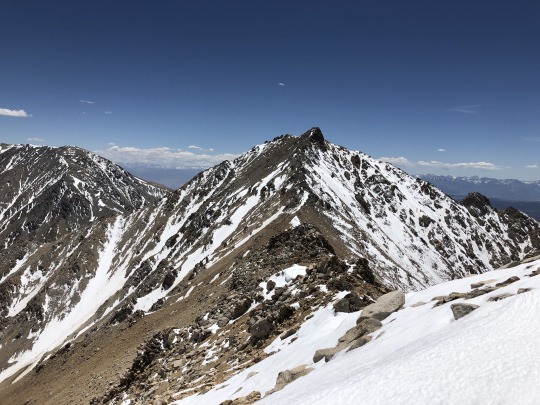
Memorial Weekend was approaching and I wanted to plan a family trip up a noteworthy peak. Believe it or not, I actually caught Asaka perusing Peakbagger one night. She was looking at state high points. She already has climbed the high points of California, Hawaii, Oregon and Washington (in addition to the high points of Mexico and Japan), so it made perfect sense to climb the high point of Nevada next. I had put off this peak for no good reason, so now I finally had enough motivation to write this one down on my official calendar. Also in the nearby vicinity of Boundary Peak is Montgomery Peak, which I needed to climb as well. I studied the distance, elevation gain and difficulty of the two peaks and came to the conclusion that I would be able to carry the baby to the summit of Boundary Peak, but it would not be prudent to continue to Montgomery Peak with the baby. Since Asaka was mostly interested in the Nevada high point, we agreed that I could leave the baby with her on Boundary Peak, and she could get a head start and carry Leif down the mountain without me. The second major challenge was how to manage the long drive. Our solution was to break it up in segments. We planned to lay over one night at my family cabin in Sonora. Our second night we planned to stay at Benton Hot Springs, stopping along the way for lunch and a short hike. Our third night we planned to camp near the trailhead at Queen Canyon Mine after doing a few short hikes in the greater Benton area. For the sake of completion, I will include a short summary of these small side hikes in my trip report.
I sent out some feelers to some prospects that I guessed would be interested. Brett Marciasini, Scott King and Sean King took the bait. I then extended the invite to some of my non-hiking friends Brian and Zach. I refer to them as my non-hiking friends not because they don’t hike, but because our friendships started from working at Texas Instruments at one point in time. They have been projects that I have been sculpting over time in the effort to develop new hiking partners. This would be a good test for both of them, as I planned a hybrid dirt bag weekend. While I usually take care of most of the specifics with regards to preparation, this time I felt they were ready to take on more responsibility, such as managing their own food, lodging and transportation. This new freedom would allow me to focus more on my wife and baby.
After our first night in the cabin, we drove over Sonora Pass and then down Highway 395 to the Mobile Mart where we had lunch. There was an easy peak called Sagehen Peak referenced in Andy Zdon’s book “Desert Summits” that I wanted to climb. Good dirt roads took us to the Sagehen Saddle, located less than a half mile from the summit. We possibly could have driven up to the summit, but we were all a little restless from riding in the car and we wanted to get some fresh air. After a short walk up the sandy road, we found a rocky outcropping that required a short, easy scramble. It was easy enough for me to climb with the baby in my arms.

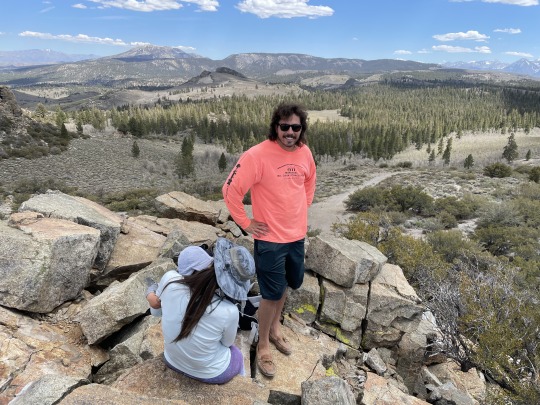

Off towards the east were Boundary Peak, Montgomery Peak and Mt Dubois. A late season storm struck the Whites a week prior, and there was a little more snow that I anticipated.
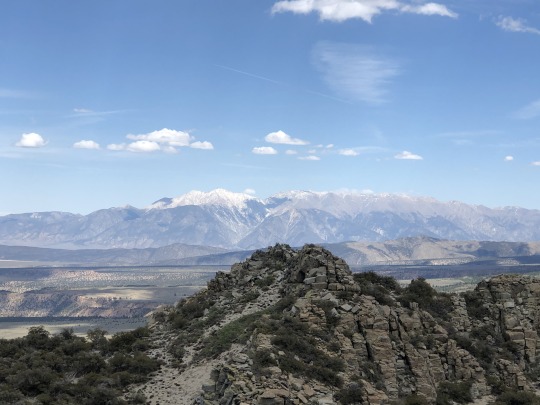
To the north was Mono Lake.

It was a nice little peak, and we rested awhile on top, but there was a slightly higher summit called Crooked Benchmark to our west. We started back down the road so I could get started on the bonus peak.

A twister swirled through the forest on this calm and sunny day.
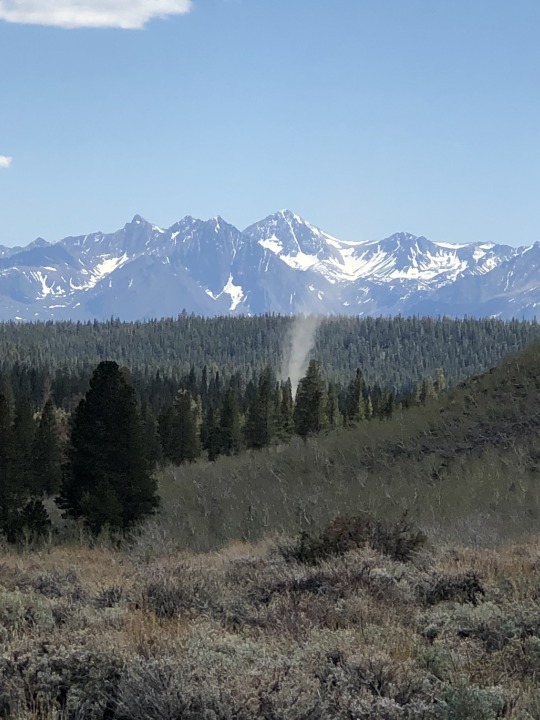
Zach decided to join me for Crooked Benchmark while the others waited at the car. I didn’t even bother putting on my hiking shoes expecting an easy walk up, but we soon found ourselves bushwhacking through willows. Zach decided early on that this was not fun, and smartly made the decision to turn around. My obsessive compulsiveness had me push forward, but it was rather unpleasant. I kept thinking that the brush would abate, but it remained consistent almost all the way to the top. I found a register at the summit and I had a good view of the Sierra Nevada.
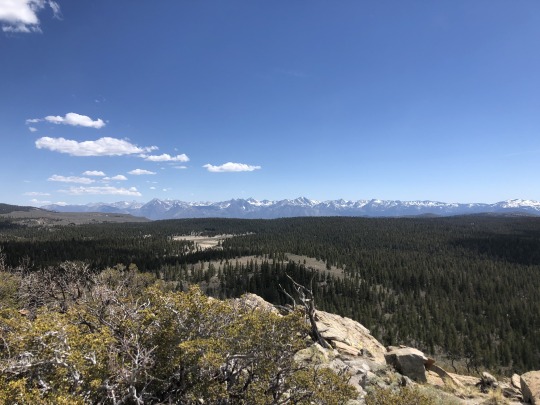
I didn’t want to retrace my steps back down to the car. I walked to the ridge and yelled down at the others to pick me up on the south side of the summit. I don’t think they were able to understand me. I also sent a GPS pin to Brian, but received no response so was unsure if he got it. The southern slopes were much easier. I dealt with some sage brush scratching my shins, but this was a minor inconvenience. I walked out the road, and I eventually found the others parked where I left the pin. We then drove to Benton Hot Springs where I checked in for the evening. We barbecued on Zach’s grill and drank some beer.


I felt a little awkward since Zach and Brian would be left on their own to camp in the desert while Asaka, Leif and I had reservations at the historic inn. I booked the last available room and there was simply no other option. I drove them to a flat tract of BLM land and apologized. Zach responded by stating something along the lines of, “Are you kidding me? This area is incredibly beautiful and we are happy to stay here.”
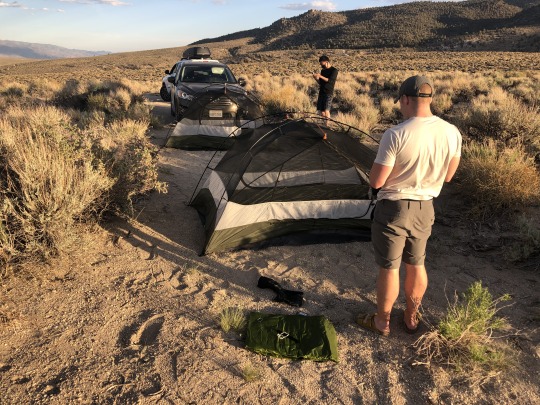
It was beautiful as dusk descended upon the snow covered Boundary Peak and Montgomery Peak above. I no longer felt guilty. Leif was sleeping when I returned, so Asaka and I snuck out to enjoy the hot springs.

Montgomery Peak was visible from our tub.

The next morning we regrouped at Benton Hot Springs and awaited the arrival of Brett and the Kings. After a round of introductions, we followed Yellow Jacket Road south through the Benton Paiute Reservation. I turned left on a 4WD road I spotted from satellite view and the topo map. We planned to hike from here, but I decided to see how far I could drive. Scott was a little less zealous about driving up the road than I was, so he and Sean piled into Brett’s truck and they followed me. With a great deal of patience, we made it almost the whole way up the peak. We parked at a mine in between Blind Spring Hill and Diane Peak.
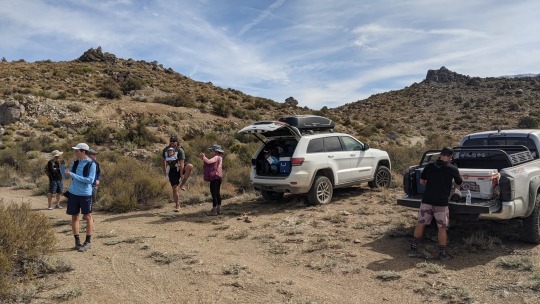

It took us all but five minutes to reach the to of Blind Spring Hill.
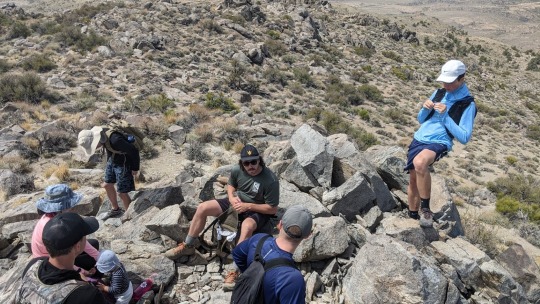

To the southwest was the Sierra Nevada.

To the west was Glass Mountain Ridge.

To the east were Montgomery Peak and Mt Dubois.
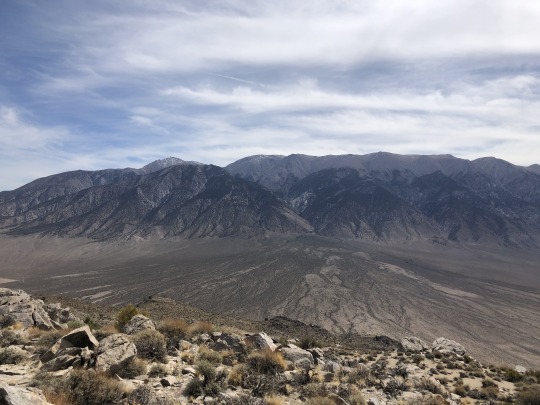
To the southeast was White Mountain.

While the peak was “just okay”, the summit register contents were a treat. Scraps went back to 1966.
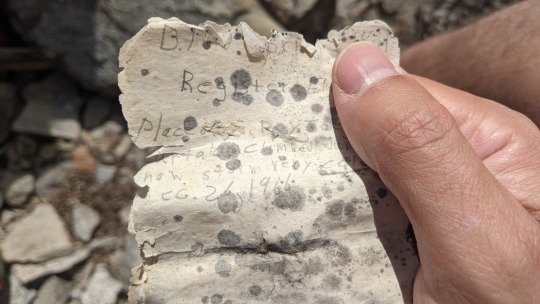
The refurbished book was a standard Gordon Macleod and Barbara Lilley register, which is almost a standard for all the arcane desert peaks throughout the southwest.
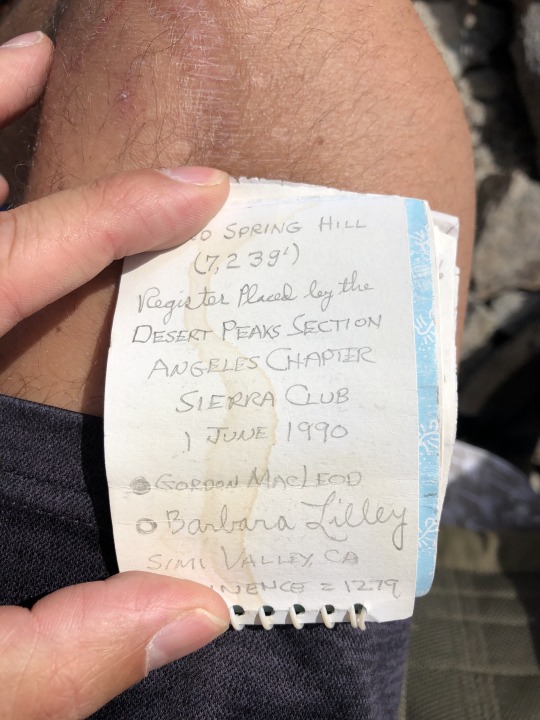
One of the early signatures was from Andy Zdon, the author of “Desert Summits”. If was solely because of his book that I decided to climb this peak in the first place.

In addition to Blind Spring Hill, there are six other named summits in close proximity along this ridge. These little peaklets were most likely named because of mining claims, and are hardly peaks at all. Since we had a full day ahead of us, we decided to only climb Diana Peak as a bonus peak, as this was less than a quarter mile from our car.
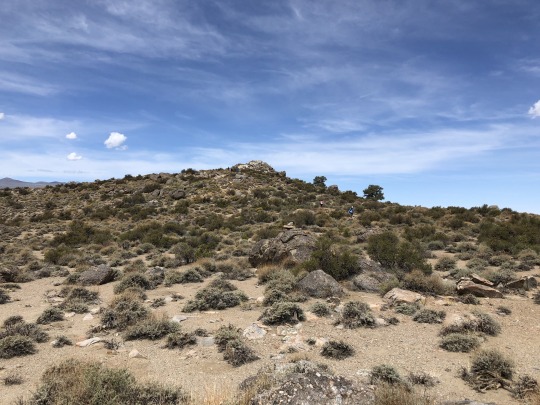
The little bump was not much of a peak, but allowed us to pad the stats.
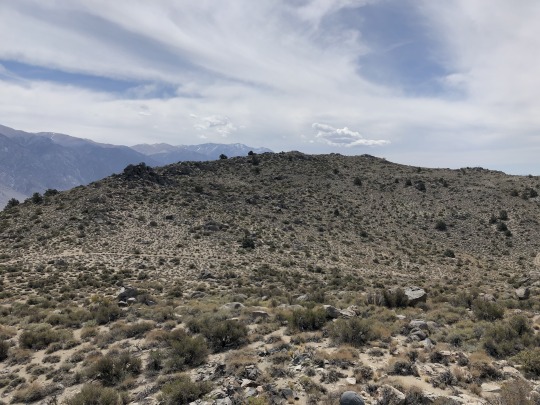
We walked back down to the car and drove back to Benton. We were ahead of schedule so we decided to visit Trafton Mountain and Antelope Mountain just north of town. I led the way with my Jeep, but unknowingly made a big navigational error. There is a very good 2WD road that follows a powerline that crosses over the saddle between Trafton Mountain and Antelope mountain, but I somehow missed it. Instead, I led the group up a rarely driven 4WD road. It was incredibly rough and sketchy in parts. At one point we had to get out of our vehicles to move a fallen tree.
youtube
I was relieved to finally reach the better powerline road, but I was a little ashamed. We wasted a lot of time and mental energy dealing with that section of road. Asaka and Leif decided to skip Trafton Mountain and instead ate some lunch. We left them in the shade and started hiking towards the peak.
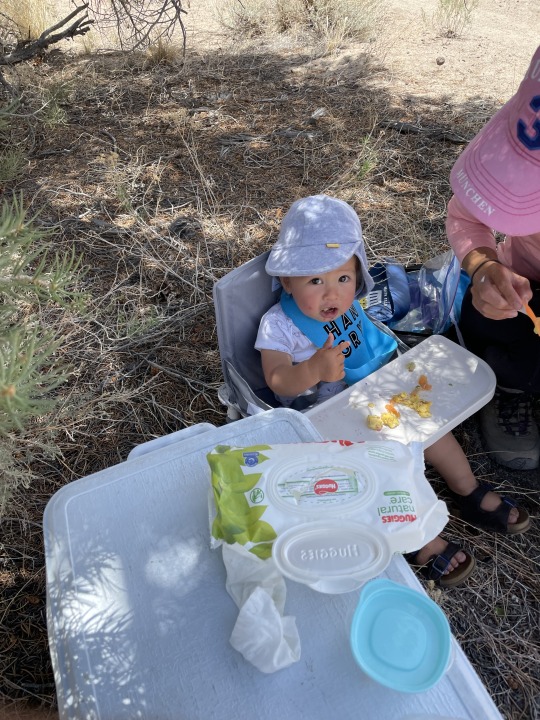
We hiked southwest up sandy and rocky slopes. It was a little too warm for my liking. Brian ran into a little issue when he kicked a cactus with his finger shoes. It took us about an hour to reach the summit.
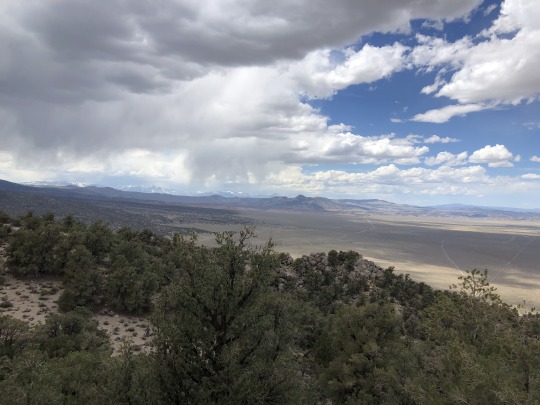
We were again blessed with another Zdon signature in the register.
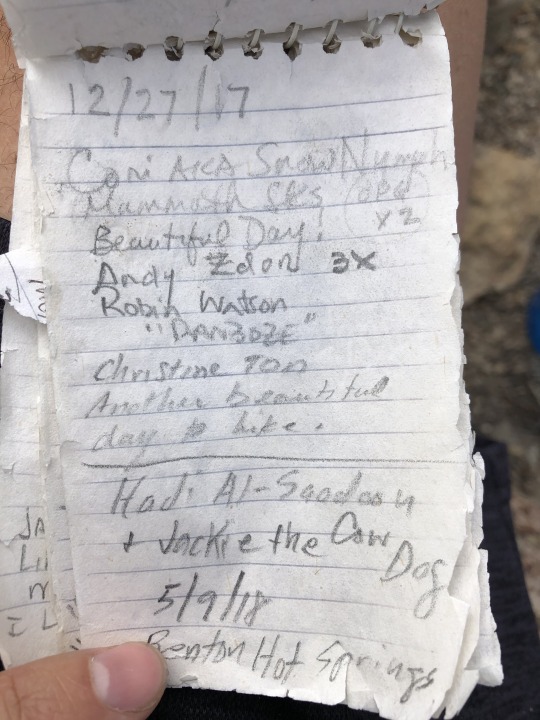
One the way down we found the remains of a deer.

Brett had a go at it, ripping the head clean from the still attached leg.
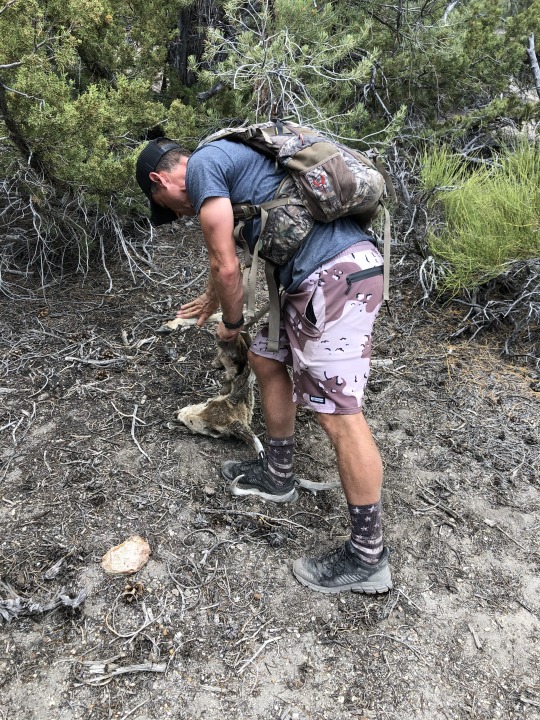
Brian was a little surprised to see us admire the carcass with such enthusiasm. I told him that dismantling dead animals is what white people do for fun.
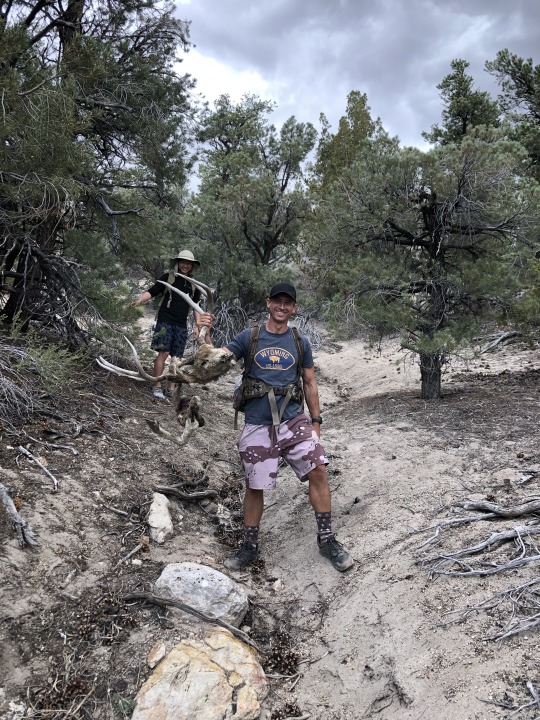
We found sandy slopes on the way down. In the end it was a 2.6 mile outing.

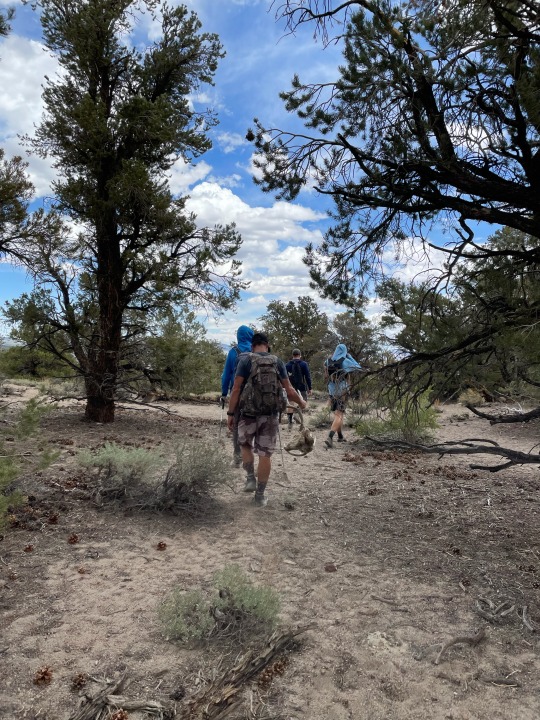
Once reunited with Asaka and Leif, we got back in the car and followed a spur road all the way to the summit of Antelope Mountain. There were several structures on the summit. To the west was the salt flat called Antelope Lake.

To the south was Trafton Mountain.

I was mostly satisfied after 3 summits from Andy Zdon’s book. We drove back to the freeway following the good road this time. The difference was night and day. After filling up gas in Benton, we drove into Nevada, then took a right on Queen Mine Road. We spotted a Mustang in the canyon below Mustang Peak.
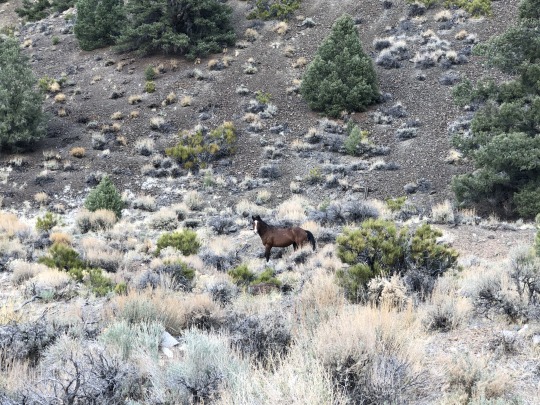
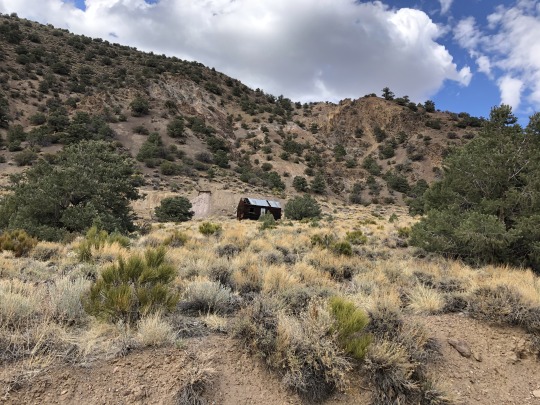

We stopped at Queen Mine where we decided to spend the night. We considered camping at the Queen Mine Trailhead, but settled on this location because it offered wind protection. Also, it was a really cool spot.


We spent the next few hours grilling Brett’s self-killed Bison, drinking beer and listening to music by the campfire. Sean and I thought about heading up Mustang Mountain, but in the end I decided against it, feeling a little worn out from earlier.
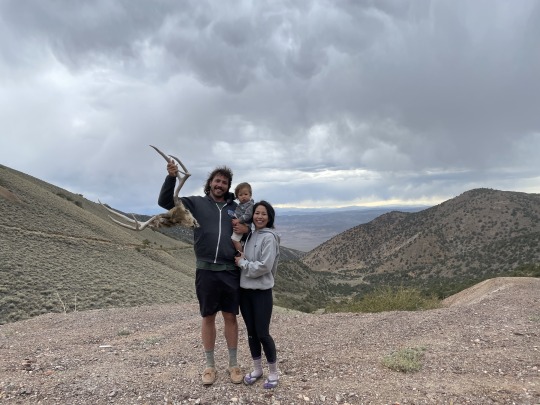
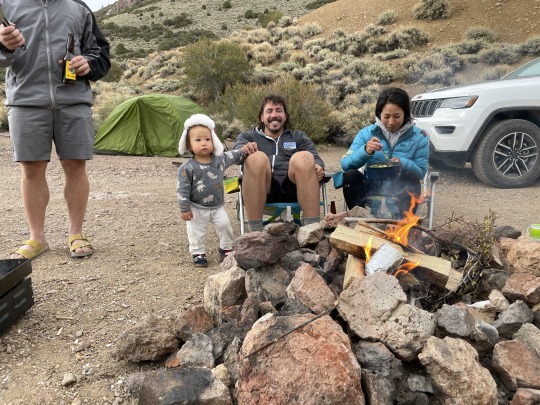
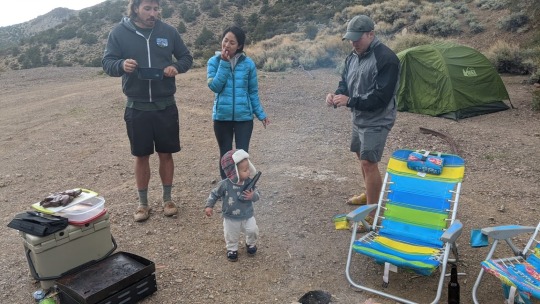
youtube
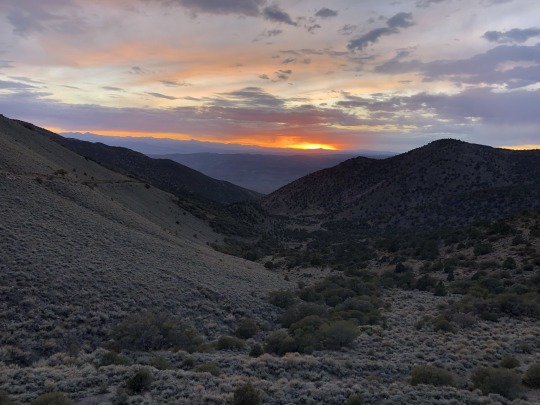
The next morning we drove the remaining mile up the road to the Queen Mine Trailhead. My Jeep and Scott’s 4Runner had no problems with the road.

I told everyone not to wait for me, since I would be slow carrying the baby. Asaka picked up Leif and then left me! That message wasn’t meant for them.

I organized some last minute things then started off at 6:45am.

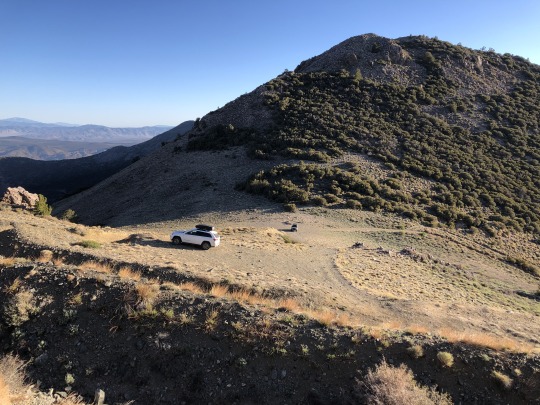
The trailhead is at 9,800 feet, which is pretty high. I spent the first mile or so focusing on breathing. Asaka thankfully waited for me and we hiked in unison.

It felt like a Martian landscape with the moon setting above the desolate terrain.

There was a really good trail climbing up the ridge. A lone deer watched me as I slowly lugged my payload uphill.
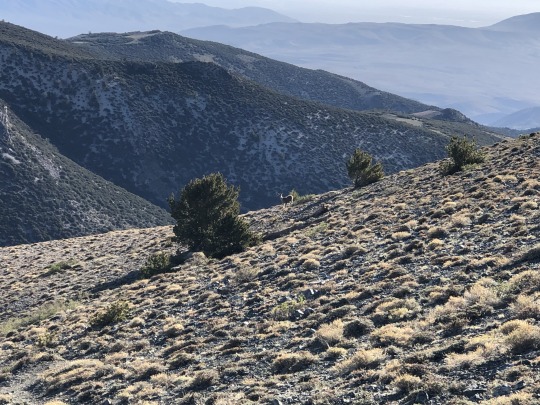
Even with my extra weight, I passed Brian early on. I hoped that this hike wasn’t too much for him. After a mile, Boundary Peak came into view.

T'was a lovely family day.
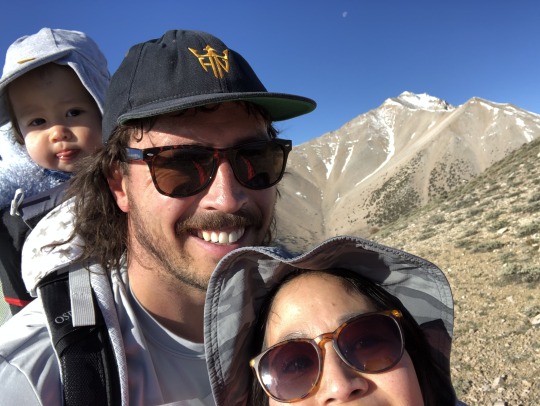
The trail stayed flat for 1.7 miles until Trail Canyon Saddle. Brett, Zach and the Kings were already way ahead of us and out of sight.

To my pleasant surprised, we ran into a herd of mustangs.
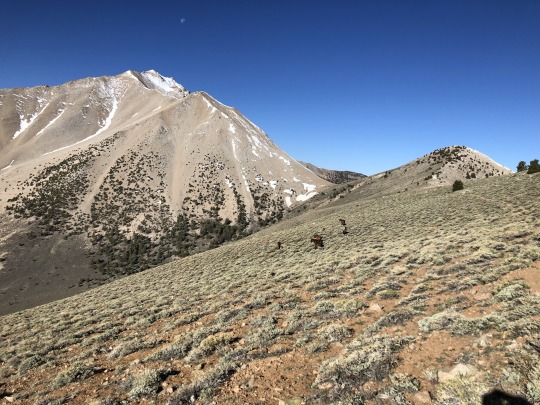
I think one of them was pregnant. There were several foals among the herd.

Brian paused for a while to photograph the ungulates.

We stopped for Leif’s breakfast along this flat portion. Maintaining his schedule is very important, even if it means falling further behind the group. He ate his blueberry oatmeal and banana without a care in the world. I was concerned since Brian hadn’t caught up to us by the time Leif finished his breakfast, but my priority was with my family. We continued all the way to Trail Canyon Saddle.

The fun part was now over for me. From here on out, I had to put in the work. The route continued steeply from here on out, but this was made easier since the trail remained underfoot. I finally spotted Brian down below and by all indications he was continuing. Across the saddle was Trail Canyon Saddle Peak. I hoped to tag this bonus peak on my return.
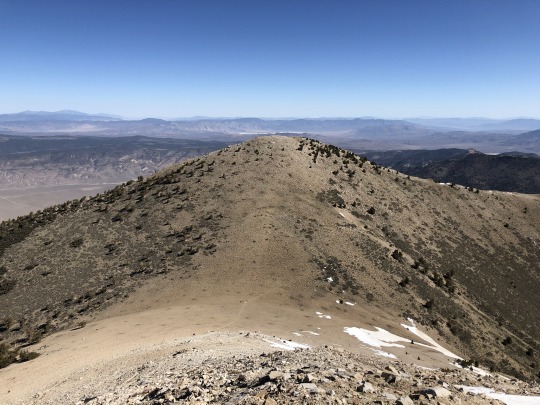
The false summit of Hosebag Peak was a little deceptive. It would have been worse if I didn’t expect. It was a little demoralizing to know that I still had to climb 1,000 feet from here, but it was still early and I was making good time.
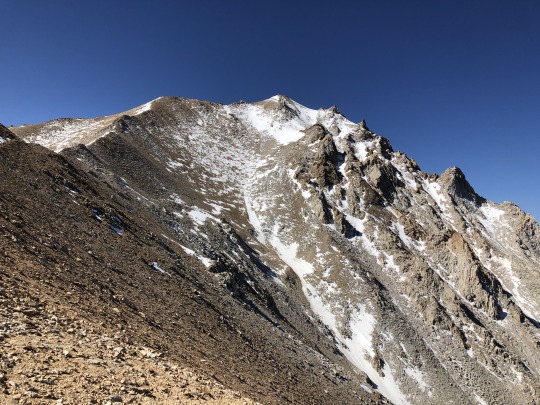
Love.

The trail stays atop the ridge. The snow caused no impediment.

The ridgeline became more serrated and the trail eventually petered out. There are class 2 ways up from here, but if one is not paying attention, they can easily find themselves on class 3.
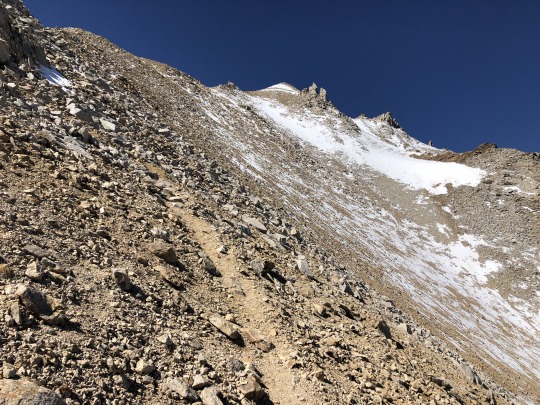
I could spot Sean and Zach on the summit from below.

Asaka chose a lower route while I stayed closer to the top of the ridge. I felt like we were going slow, but then I spotted Brett and Scott not so far ahead of us.
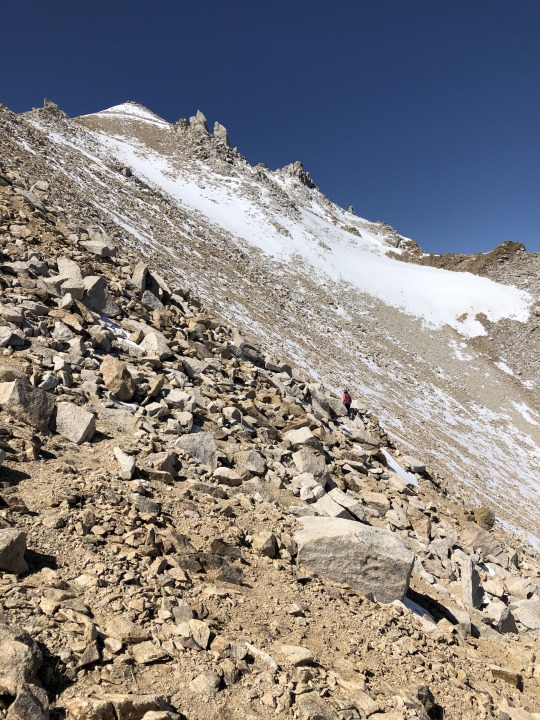
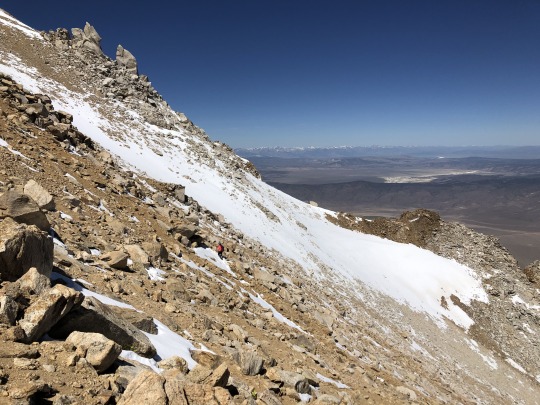
A light trail reemerged higher up the mountain. I worried that Sean and Zach were waiting too long for me on top. I worried that Brian wouldn’t make the summit.

I had to cross some soft snow as I neared the top, but this was not a challenge. Montgomery Peak finally came into view beyond.
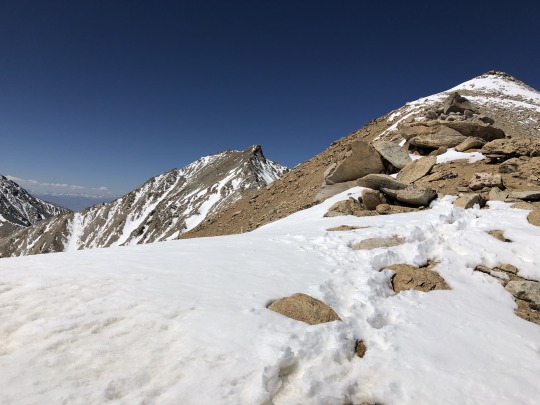
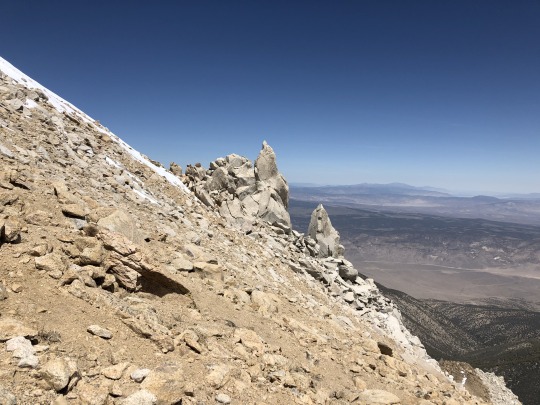

We reached the summit at 10:45am, four hours after we started out.

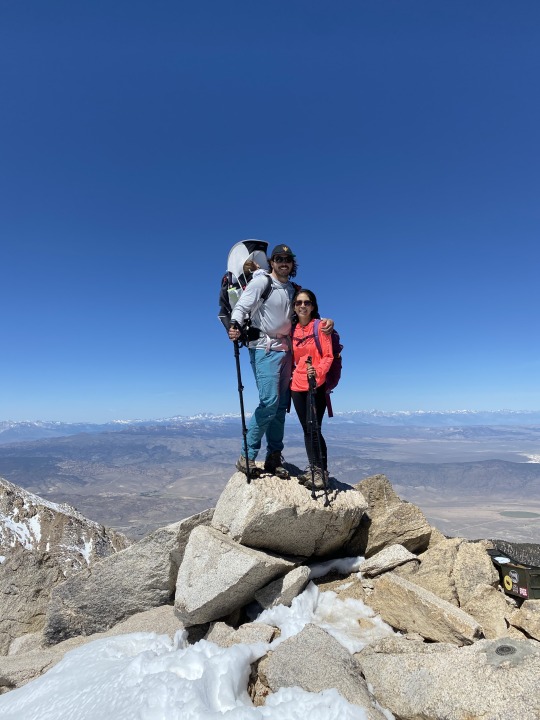
I unloaded the baby, inadvertently waking him in the process. Hey bud, welcome to the high point of Nevada.
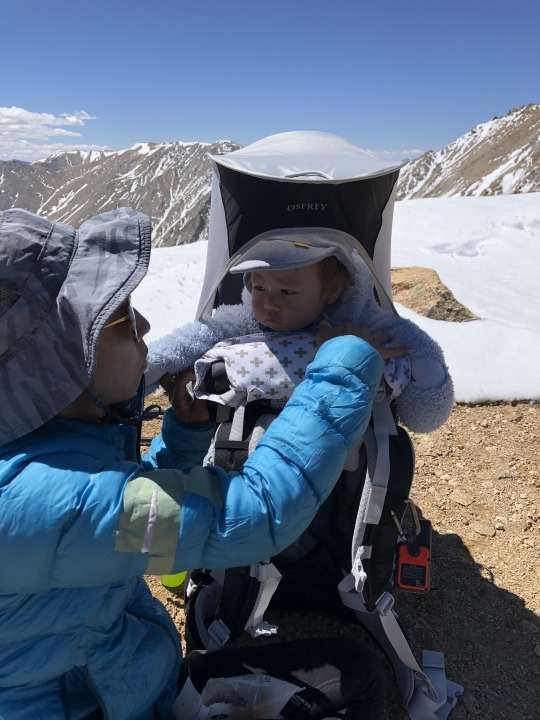
Sean had been waiting on the summit for over an hour. He beat Zach by 20 minutes. Brett and Scott were only about 10 minutes ahead of Asaka and me. Brian was still nowhere to be found. I texted Brian and told him that he had a 1pm turn around time, and I told Scott to tell Brian to turn around if he had not made the summit by that time. I relieved myself of baby carrying duties and let Asaka take care of the rest. Brett, Sean, Zach and I turned our focus to Montgomery Peak. We dropped off the mountain and hiked towards the saddle where we crossed the California and Nevada border.
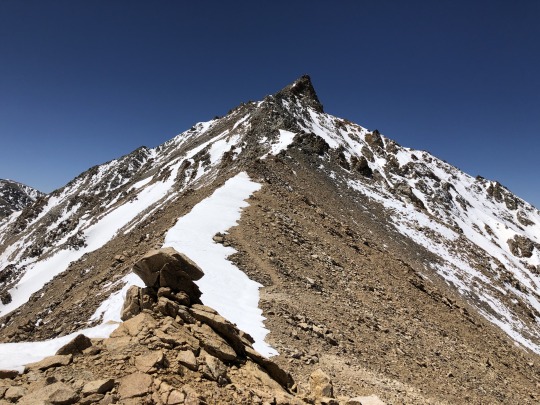
We had read a diverse set of claims from various trip reports and weren’t quite sure what to expect. In the end, the traverse was mostly class 2 with some easy class 3 and a few sections of loose rock.
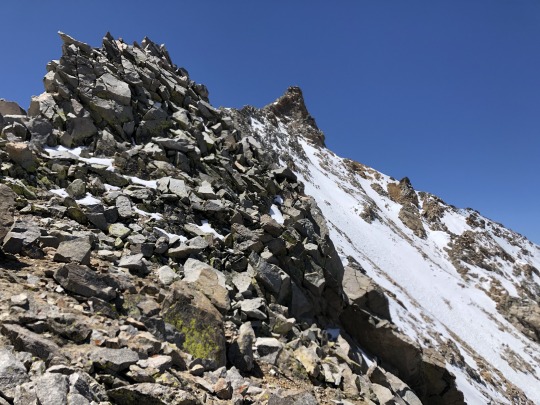
We hiked mostly on top of the ridge, but in the places where the ridge became sharp, we stayed underneath the left side. The route finding was very easy and well placed cairns but and end to any doubts.

A lone climber passed us on the final stretch. Once on the summit we introduced ourselves and I learned that he went to my same climbing gym in San Jose. To the north were Mt Dubois and White Mountain.

To the southwest were Benton Point and the Sierra Nevada.

Way below us to the northwest were the diminutive Trafton Mountain and Antelope Mountain. Beyond that were the high peaks of Yosemite and a sliver of Mono Lake.
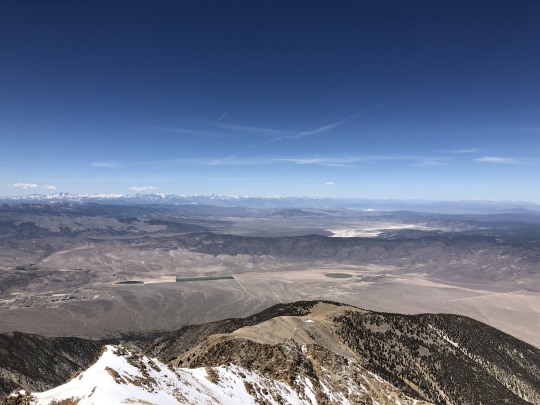
Way off to the north were Mt Grant and Walker Lake.

To the northeast were the Volcanic Hills and desert wasteland.

To the east ran Middle Creek Canyon.

The conditions couldn’t have been better. On our return, we decided to pick a route staying along the top of the ridge. Brett, who was a little nervous of the ridge traverse at first, mastered this knife edge section and proved to all that he is a master scrambler.

-Middle Creek

Our remaining group was gone by the time we reached Boundary Peak.

We took only a short break here before descending back down. Brett and I stopped to bag Hosebag Peak, which stood just a few minutes off the trail. Sean already did this on the way up, and he had his eyes set on the bonus peak Mustang Mountain on the other side of Queen Canyon Saddle. Zach didn’t seem to care about any more bonus peaks and simply continued down.


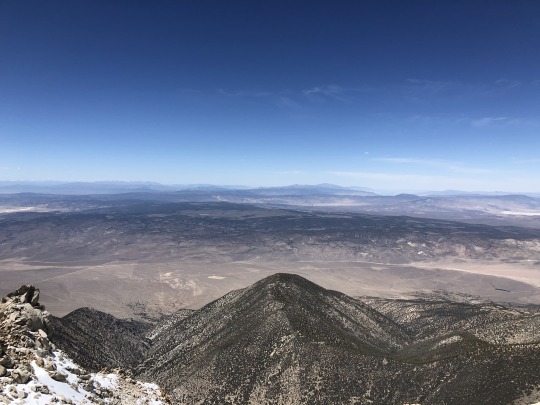

From Hosebag Peak, we followed the trail down to Trail Canyon Saddle.


Brett and I then marched up barren slopes to the summit of our last bonus peak for the day.

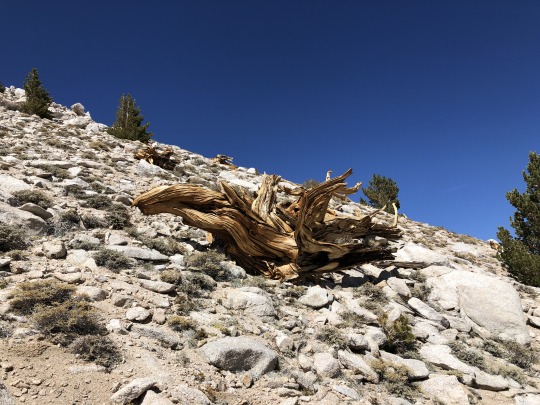
The views from the summit were sublime.
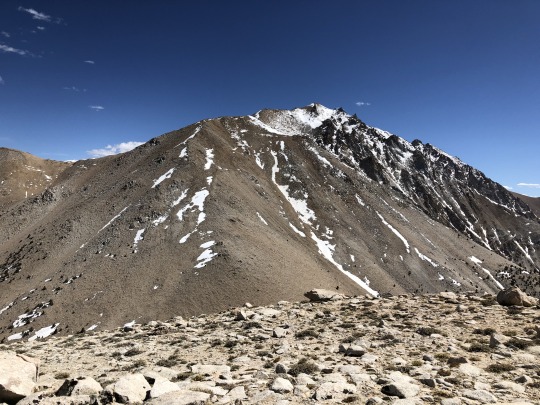
From the summit, we continued down the ridgeline until we naturally intersected the trail.

I left Brett somewhere along this off trail section and began a powerwalk once I reached the trail.

I soon caught up to Brain. I was thrilled to learn that he made the summit before his turn around time. He seemed to be having a great day.

I was surprised to catch Zach next. He was seriously feeling the altitude. I bade him farewell and continued ahead. Asaka and Scott just barely beat me back to the car. I was happy to see my wife and baby happy and in one piece. Apparently Leif spotted a herd of deer and pointed them out to the previously unaware Asaka and Scott.

Brian finished the hike at the same time that Sean came back from Mustang Peak, so timing was perfect. After some hydrating, we all hopped back in the cars and drove back out to Highway 6.
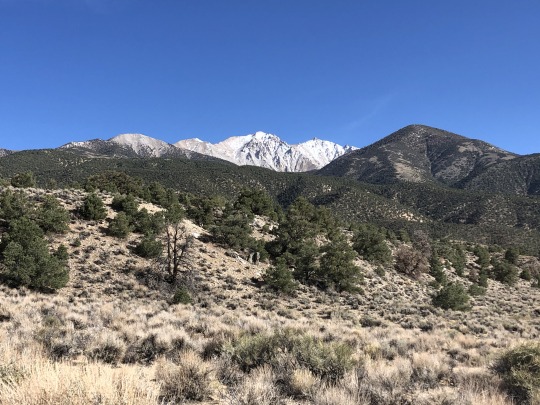
Once on pavement, we said goodbye to the Kings who had High Sierra plans later in the week. The rest drove back to Lee Vining for dinner. Asaka was tired and the baby was fussy, but things got better once we all got some dinner inside of our bellies.

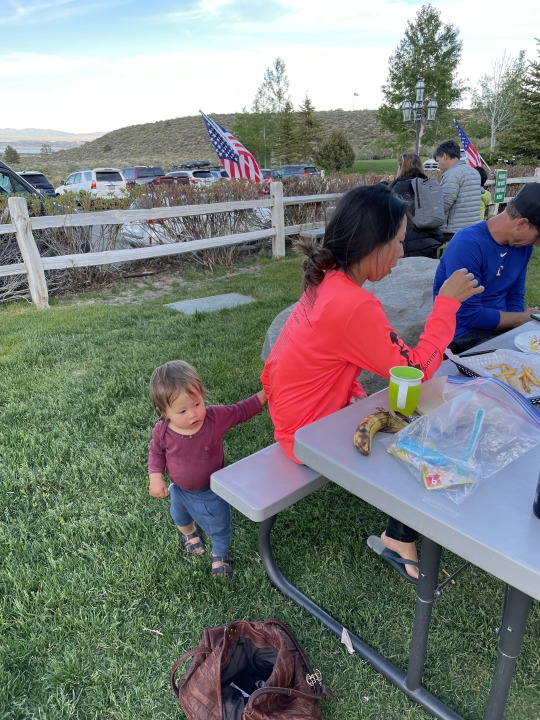
After dinner, we found a dirtbag spot just outside of Bridgeport where we spent the night. We planned to climb South Sister in the Sweetwaters the following day before driving back home to the Bay Area.
2 notes
·
View notes
Text
Saturday, July 10, 2021
Billionaire Blastoff (AP) Two billionaires are putting everything on the line this month to ride their own rockets into space. Virgin Galactic’s Richard Branson is due to take off Sunday from New Mexico, launching with two pilots and three other employees aboard a rocket plane carried aloft by a double-fuselage aircraft. Blue Origin’s Jeff Bezos departs nine days later from West Texas, blasting off in a fully automated capsule with three guests: his brother, an 82-year-old female aviation pioneer who’s waited six decades for a shot at space and the winner of a $28 million charity auction. They will go 55 miles to 66 miles (88 kilometers to 106 kilometers) up.
Severe heat wave builds across Western U.S. after nation’s hottest June on record (Washington Post) Last week, a “thousand-year” heat wave baked the Pacific Northwest and adjacent British Columbia with widespread highs topping 100 degrees, resulting in a death toll in the hundreds. Lytton, Canada, climbed to 121 degrees and established new national records three days in a row before the town burned in heat-intensified wildfires. The National Oceanic and Atmospheric Administration announced Friday that the heat wave helped the United States clinch its hottest June on record. Eight states had their hottest Junes, including Arizona, California, Nevada and Utah. These four states are at the heart of yet another heat wave developing in the West that could challenge records and bring dangerously hot temperatures. It will mark the third punishing heat wave in the West this summer, including last week’s in the Pacific Northwest and a record-breaking event in mid-June. This heat wave will not likely be as extreme as the event in the Pacific Northwest, but temperatures could challenge all-time highs around Las Vegas, Redding, Calif., and Sacramento and a few other places between California’s Central Valley and southern Nevada.
Political Crisis in Haiti Deepens Over Rival Claims to Power (NYT) The political storm in Haiti intensified on Thursday as two competing prime ministers claimed the right to run the country, setting up an extraordinary power struggle over who had the legal authority to govern after the brazen assassination of President Jovenel Moïse in his home the day before. Haiti’s interim prime minister, Claude Joseph, says he has taken command of the police and the army, declaring a “state of siege” that essentially put the country under martial law. But constitutional experts questioned his right to impose it, and his claim to power was quickly challenged by a rival. Two days before his death, Mr. Moïse had appointed a new prime minister, Ariel Henry, a neurosurgeon who was supposed to take up the role this week and told a local newspaper that he was the rightful prime minister instead. The dueling claims created a volatile political crisis that left constitutional experts confused and diplomats worried about a broad societal collapse that could ignite violence or prompt Haitians to flee the country en masse, as they have after natural disasters, coups or other periods of deep instability.
Brexit bill (Reuters) Brexit’s unfortunate fallout continues. The European Union has said that the United Kingdom is liable to pay 47.5 billion euros ($56.2 billion) to the E.U. as part of its post-Brexit financial settlement. The E.U.’s consolidated budget report for 2020 said the money is owed under a series of articles which both sides agreed to as part of the Brexit withdrawal agreement. The amount is significantly higher than the U.K. expected. Its Office for Budget Responsibility predicted in its March 2018 economic and fiscal outlook report that the bill would amount to 41.4 billion euros ($49 billion). Britain and the E.U. were in a 47-year relationship, and the divorce has been dicey. It took more than four years of acrimonious negotiations and lingering mistrust before the two finally struck a trade and cooperation agreement at the end of December.
Thailand to impose tighter restrictions to slow virus spread (Reuters) Thailand will announce new travel restrictions, mall closures and curbs on gatherings in the capital Bangkok and surrounding provinces starting next week, in an effort to slow the spread of the coronavirus, two government sources told Reuters. The government will issue a stay-home order from 9 p.m. to 4 a.m. for 14 days and bar gatherings of more than five people in the capital and high-risk areas, the sources said.
China’s gaming curfew (Foreign Policy) Chinese gaming giant Tencent will begin using facial recognition technology to prevent minors playing mobile video games past a nationwide gaming curfew. China established the 10 p.m. to 8 a.m. curfew in 2019 to combat gaming addiction—deemed a mental health disorder in 2018 by the World Health Organization. Chinese children and teenagers had been circumventing the nighttime ban by using adult’s credentials to log in to the gaming service, prompting the technological intervention.
Biden Accelerates Withdrawal Timetable (Foreign Policy) U.S. President Joe Biden on Thursday defended his decision to withdraw U.S. troops from Afghanistan, despite the Taliban’s rapid territorial gains in recent weeks. In a White House address, Biden said that all combat troops would leave Afghanistan by August 31, even earlier than a Sept. 11 deadline he set back in April. Heading off criticism from some conservatives, who have called for a small combat troop presence to remain in the country, Biden—a long-time skeptic of prolonged U.S. involvement in Afghanistan—questioned the cost of such a move. “Let me ask those who want us to stay: How many more—how many thousands more Americans, daughters and sons—are you willing to risk?” Biden said. “I will not send another generation of Americans to war in Afghanistan with no reasonable expectation of achieving a different outcome.” Although nearly all U.S. troops are set to depart Afghanistan by August, a substantial number—roughly 650—will remain in the country to provide security for the U.S. embassy and Kabul’s international airport.
Drone attacks by Iraqi militias reflect Iran’s waning hold (AP) Iran’s expeditionary Quds Force commander brought one main directive for Iraqi militia faction leaders long beholden to Tehran, when he gathered with them in Baghdad last month: Maintain calm, until after nuclear talks between Iran and the United States. But he was met with defiance. One of the six faction leaders spoke up in their meeting: They could not stay quiet while the death of his predecessor Qassim Soleimani and senior Iraqi militia commander Abu Mahdi al-Muhandis in a U.S. drone strike went unavenged. Militia attacks have only been increasing against the U.S. in military bases in both Iraq and Syria. Three missile attacks in the last week alone resulted in minor injuries, stoking fears of escalation. There have been at least eight drone attacks targeting the U.S. presence since Biden took office in January, as well as 17 rocket attacks, according to coalition officials. The attacks are blamed on the Iranian-backed militias that make up the bulk of Iraq’s state-supported Popular Mobilization Forces. The Biden administration has responded by twice targeting Iraqi militia groups operating inside Syria, including close to the Iraqi border.
Israel levels family home of alleged Palestinian attacker (AP) Israel on Thursday demolished the family home of a Palestinian-American man accused of carrying out a deadly attack on Israelis in the occupied West Bank, rejecting pleas from his estranged wife that he rarely lived in the house, which she shared with their three children. The demolition drew a rebuke from the United States, which is opposed to punitive home demolitions and has taken a more critical line toward Israel’s policies in the occupied West Bank since President Joe Biden took office this year. “The home of an entire family should not be demolished for the actions of one individual,” said U.S. State Department spokesman Ned Price. “There is a critical need to lower the temperature in the West Bank. Punitive demolitions exacerbate tensions at a time when everyone should be focused on principally ensuring calm.”
Religion (Public Religion Research Institute) A new survey of 50,334 Americans over the course of 2020 tracked how religion in the United States has continued to change over recent years. According to the survey, 36 percent of those 18 to 29 years old considered themselves unaffiliated with a religion, substantially higher than the 23 percent of 18 to 29-year-olds who considered themselves as much in 2006, and the 10 percent who were unaffiliated in 1986. That’s also double the rate of religiously unaffiliated compared to those aged 50 to 64. Still, a majority—54 percent—of those 18 to 29 are Christians, though that’s down from the 70 percent of all Americans.
Laughter can make you more productive at work (CNBC) Being inundated with bad news and working from home, for some alone, during the coronavirus pandemic has made it harder than ever for workers to find the time for laughter, but experts argue that it can really make a difference when it comes to productivity. Daniel Sgroi, an economics professor at the U.K.’s University of Warwick, told CNBC via telephone that laughter can trigger the activation of neurotransmitters such as dopamine and serotonin, both of which are considered mood-boosting hormones. Sgroi explained that laughter “fast tracks networks in the brain to help you concentrate and focus,” working as the equivalent of a productivity boost. Research that Sgroi co-authored, published in 2015, found evidence of a link between happiness and productivity. One of the techniques used in his study was to use comedy to make participants laugh and be happier, which he said boosted productivity by up to 12%. “So it’s almost like being happy generates more time,” he said, explaining that someone who is happy might be able to do in one hour what it takes someone who is less happy to do in an hour and 20 minutes.
1 note
·
View note
Photo
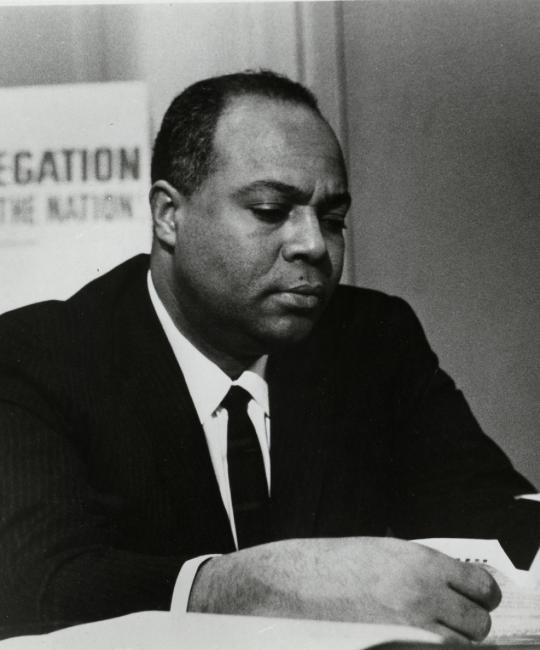
The conscientious James Farmer
Background and Education
Freedom Ride leader James Leonard Farmer Jr. was born on January 12, 1920, in Marshall, Texas. His mother was a teacher and his father a minister who was also the first African-American citizen to earn a doctorate in the state. Surrounded by literature and learning, the young Farmer was an excellent student, skipping grades and becoming a freshman at Wiley College in 1934 at the age of 14. While there he continued to excel as part of the debate team, and his eloquence and storytelling abilities would later be heard nationally as an adult.
(Farmer's life as a star college orator was portrayed in the Denzel Washington-directed film The Great Debaters, where Farmer Jr. was played by Denzel Whitaker and his father by Forest Whitaker, with no real-life relation between the two actors.)
Studies Gandhi's Path
Previously contemplating a career in medicine, Farmer then thought he would follow in his dad's footsteps and take up ministerial work, earning his divinity degree from Howard University in 1941. While there he learned about the life and teachings of Mahatma Gandhi. Farmer studied much of Gandhi's philosophies and would apply the leader's ideas of nonviolent civil resistance to U.S. racial desegregation.
Opting not to forge a career in religion either, Farmer was a conscientious objector during World War II and worked with the Fellowship of Reconciliation by the early 1940s. Living in Chicago, Illinois, he was also a TV screenwriter and magazine scribe.
Farmer was in a first marriage with Winnie Christie from 1945 to '46, and in 1949 married Lula A. Petersen, with whom he had two children.
Founds CORE
Committed to racial harmony, Farmer, his friend George Houser and a multi-racial group of colleagues decided that they would desegregate a Chicago eatery via a 1942 sit-in. They thus formed the Committee of Racial Equality, with the name later becoming the Congress of Racial Equality. With Farmer elected national chairman, CORE developed a mostly white North-based membership with various chapters, yet would eventually find itself becoming deeply involved in the South.
Farmer had some periods away from the organization, but with the Civil Rights Movement making headlines with historical rulings and actions, he was elected to become national director of CORE in February 1961. Farmer thus became one of the most prominent African-American leaders of the era, joining the ranks of figures like Dr. Martin Luther King Jr. and Roy Wilkins.
The Freedom Rides
Farmer worked on launching the Freedom Rides with the intention of challenging segregation on intestate bus travel, which had technically been declared illegal in 1946 and which CORE had taken action upon previously. The Freedom Riders consisted of both women and men, black and white who traveled on bus routes through Southern states.
The first ride was launched in May of 1961, with the bus firebombed upon reaching Alabama after travel through several states. Other riders were mobilized, yet the brutality was horrifying, with one rider having been beaten so badly he was left paralyzed for life and protesters jailed en masse in Jackson, Mississippi. Audiences around the world were able to see via television violent racism at work, and in September of 1961 the Interstate Commerce Commission—at the behest of Attorney General Robert Kennedy—declared segregation impermissible in Southern public travel facilities and modes of transport.
CORE, also at the helm of hiring-based protests in the North, continued its prominent work in the South, with Farmer being targeted for his leadership and jailed and three CORE-affiliated workers murdered in Mississippi in 1964.
Farmer eventually resigned from leading CORE in the mid-1960s. His book Freedom—When? was published in 1966 and, after a stint teaching at Lincoln University, he ran unsuccessfully for Congress on the Republican ticket against Democrat Shirley Chisolm in 1968. He later worked in the administration of President Richard Nixon, though he left in frustration.
Medal of Freedom
Receiving several honors for his work over time, Farmer was able to tell his story to new generations, releasing his acclaimed autobiography Lay Bare the Heart in 1985. More than a decade later he received the Presidential Medal of Freedom from Bill Clinton. And in 2011, PBS' American Experience released a documentary that focused on CORE's work entitled Freedom Riders.
Farmer had been suffering greatly from diabetes during his later years. He died on July 9, 1999, in Fredericksburg, Virginia, at the age of 79. (source)
18 notes
·
View notes
Text
TOLLS Big D
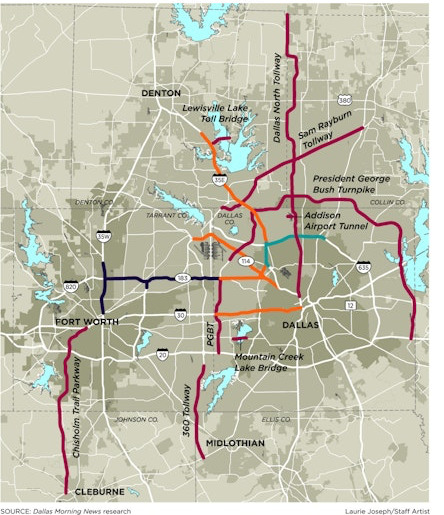
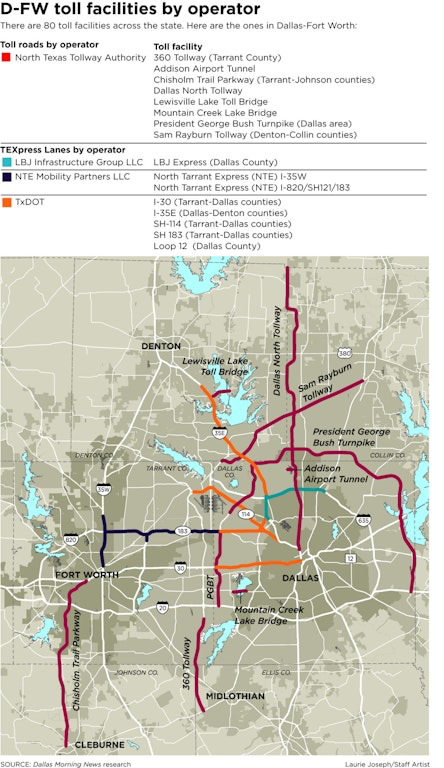
TIMELINE
From 2001 to 2021, Texas built more toll roads than nearly all other states combined.
Here are some highlights of its long history with tollways:
1953 — The Texas Legislature creates an independent entity with statewide authority to construct toll roads and bridges, the Texas Turnpike Authority.
1957 — The first toll road in the state, the Dallas/Fort Worth Turnpike, opens in North Texas on what is now known as Interstate 30. The tollway directly connects downtown Fort Worth and downtown Dallas.
1968 — The Dallas North Tollway opens in North Texas, connecting downtown Dallas to Collin County and northern Dallas to Denton County.
1977 — Tolls on the former Dallas/Fort Worth Turnpike are removed, and the road is designated Interstate 30.
1983 — Harris County Toll Road Authority opens for business after voters approve $900 million in bonds to build and maintain toll roads.
1996 — Southern California unveils the first set of “managed lanes” in the U.S. along a stretch of highway known as State Route 91. The toll lanes are built in the middle of a free road and are open to anyone who is willing to pay the fees, which can change based on the amount of congestion on the free lanes.
1997 — The North Texas Tollway Authority is created.
1998 — President George Bush Turnpike, operated and maintained by the NTTA, opens between Preston and Midway. Today, it is a 52-mile toll road that forms a sweeping arch across the eastern half of the Dallas-Fort Worth region.
2001 — Criminal penalties for failure to pay required toll or administrative fees become the law in Texas.
2003 — Texas enacts new laws that allow private entities to design, build, operate and finance toll roads and revenue-producing rail systems.
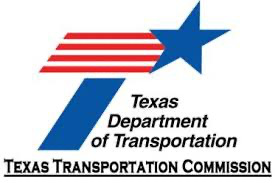
The Texas Transportation Commission is authorized to create regional mobility authorities that can build tollways and allow counties to construct and maintain toll road projects under certain conditions.
2003 — The Northeast Texas Regional Mobility Authority opens in Smith and Gregg counties and expands to more counties over the next several years.
2004 — Cameron County Regional Mobility Authority opens in South Texas. Fort Bend County Toll Road Authority opens its first toll road, the Fort Bend Parkway.
2005 — A private tollway operator unveils a proposal to develop the TTC-35 High Priority Trans-Texas Corridor, according to TxDOT. The idea, touted by then-Gov. Rick Perry, involved the construction of a 4,000-mile network of toll roads, railroad tracks, pipelines and utility lines that would stretch across the state. The estimated cost was $175 billion for a project that would take 50 years to complete. 2007 — A consortium led by Cintra begins construction of State Highway 130 in Central Texas, a 100% privately financed toll road project. This is the first comprehensive development agreement signed in Texas, known as a concession, in which a private sector company can develop, finance, construct, operate and maintain a facility for a specific period of time, up to 52 years. The developer collects tolls during the life of the agreement. The project results in a bankruptcy in 2014 and the toll road project’s financing is restructured under new ownership. Creditors blame the failure on overly optimistic financial forecasts.
2007 — State Sen. Robert Nichols, R-Jacksonville, files a pair of bills aimed at placing a two-year moratorium on road construction contracts with private companies. “We must closely evaluate private toll contracts before we sign away half a century of control of our transportation system,” he wrote at the time. Nichols recommended that the state require the developers to ensure toll rates remain reasonable and establish a formula to determine cost should the state need to terminate the contracts early.
2007 — Concerns from some members of Congress are sent to governors of all 50 states warning that rampant construction of private toll roads operated by private companies could fragment an integrated transportation system and prove a disservice to taxpayers. A key concern is that noncompete clauses make it extremely difficult if not impossible for public transportation agencies to address safety and congestion problems on highways and streets adjacent to private roads.
2007 — TxDOT’s Keep Texas Moving campaign comes under public attack after spending $9 million in state highway funds on a public relations campaign to build more toll roads. Opponents question TxDOT’s decision to partner with private companies to build toll roads.
2007 — Texans for Public Justice, an Austin-based watchdog group, finds that lobbyists spent thousands of dollars sending Texas transportation officials to events related to public-private financing of toll roads as the state prepares to launch $7 billion worth of new toll road projects. The lobbyists also paid travel expenses for 83 Texas lawmakers and transportation officials on 383 occasions between January 2005 and November 2006, according to TPJ.
2008 — The NTTA assumes responsibility for operations, maintenance and construction of State Highway 121, known as the Sam Rayburn Tollway, a 26-mile corridor through the cities of Allen, Carrollton, Fairview, Frisco, Lewisville, McKinney, Plano and The Colony.
2008 — Texas Department of Transportation officials begin to hold a series of hearings seeking public input to answer questions about the Trans-Texas Corridor project.
2008 — Reason Foundation, a libertarian think tank based in Southern California, awards then-Gov. Rick Perry a recognition for his introduction of private-sector tolls in Texas. Perry is noted as an innovator for his work in developing solutions to cope with growing infrastructure and traffic problems.
2008 — TxDOT is bombarded with criticism over Perry and its toll policies. The state Legislature places a two-year moratorium on long-term toll road agreements.
2009 — TxDOT signs a contract — executed as a comprehensive development agreement — to build the tollway known as North Tarrant Express in Fort Worth. These are segments that include Interstate 820 from Mark IV Parkway to State Highway 121/State Highway 183 and Highways 121 and 183 from I-820 and FM 157.
2009 — TxDOT enters into a $2 billion contract to construct a toll road on Interstate 635 known as LBJ Express Dallas from east of Luna Road to east of U.S. Highway 75 (near Greenville Avenue).
2011 — Regional mobility authorities are given the power to borrow money or enter into loan agreements or similar arrangements with any public or private entity.
2012 — Optional remedies for the nonpayment of tolls and administrative fees are introduced.
2013 — The Texas Transportation Commission creates the Grand Parkway Transportation Corporation, a nonprofit Texas corporation, to finance a segment of State Highway 99 known as the Grand Parkway System.
2013 — TxDOT enters into a $2 billion contract to expand the North Tarrant Express.
2016 — TxDOT enters into an $800 million contract with a private company to build toll lanes from U.S. Highway 59 to the Harris County line within the median of State Highway 288.
2019 — A new bill signed into law requires toll operators to disclose certain financial information, including revenues and expenses and capital plans over several years after construction and design costs.
2024 — The Texas Transportation Commission votes unanimously to begin the process of ending its agreement with the private company that built toll lanes in Harris County within the median of State Highway 288.
Texas Made Wrong Turn on Toll Roads
It’s time for lawmakers to reconsider costly, unfair policies
The state of Texas has abdicated its responsibility to provide necessary transportation infrastructure in exchange for a vast web of toll roads controlled by a patchwork of powerful, self-interested organizations that often act to the detriment of residents.
That’s our conclusion after reading a yearlong investigation conducted by our newsroom into how Texas built more toll roads than nearly all other states combined over the last two decades, and the alarming consequences for the public.
State leaders, seeking ways to handle an influx of residents without raising taxes, approved policies and laws far too favorable to outside toll operators, paving the way for today’s sprawling toll road network and a host of concerns, the recently published Toll Trap series reveals.
It also documents what many of us have long suspected: unfair pricing, especially during peak driving hours, and overly harsh enforcement practices that take advantage of unsuspecting motorists and that lead to economic segregation.
Some state leaders now rightly regret supporting the policies and laws that drove the toll road construction boom.
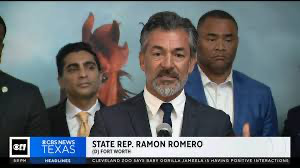
“We were sold a bill of goods,” state Rep. Ramon Romero, D-Fort Worth, told investigative reporter Yamil Berard. “We were just looking for how to find money. We now know that this was the wrong way to do it.”

If that’s not a compelling argument for reconsideration of those decisions, we don’t know what is.
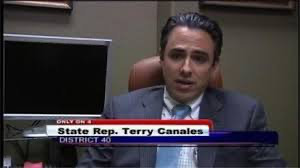
We support the efforts of state Rep. Terry Canales, D-Edinburg, chair of the House Transportation Committee, who earlier this year urged House Speaker Dade Phelan to appoint a group of lawmakers to review the state’s complex toll system and to make recommendations for reforms during the 2025 legislative session.
We call on Phelan to grant that request.
Done right, toll roads are a reasonable and smart way to fund roads.
Often privatized and built relatively quickly, they’ve allowed communities and even whole regions to handle population growth without burdening taxpayers.
North Texas in particular has benefited from these massive projects.
But our newsroom investigation highlighted several disturbing aspects of Texas’ toll road system.
For example, some lease agreements between operators and the state have allowed operators to collect tolls for 50 years, netting them excessive profits far beyond their design, construction and maintenance costs.
Toll roads also sometimes engulf whole middle- and low-income neighborhoods, making it difficult for residents who can’t afford them to make their way to free roads, which are then often highly congested, the investigation revealed.
And, particularly troubling, toll operators aren’t always required to be transparent with their financial and safety records.
With thousands of motorists driving down more than 800 miles of Texas toll projects every day, and more projects likely on the horizon, too many people are impacted by the concerns revealed in our newsroom investigation.
The Legislature must not turn a blind eye to these issues; it’s time to reconsider some of the wrong decisions that created them.
Texas tollway authorities show little mercy for Texans of color, vulnerable communities
The News’ examination found that the methods Texas uses to criminally charge vehicle owners for unpaid toll road fees may stand on shaky legal ground.
Tarrant County Justice of the Peace Precinct 5 Sergio L. De Leon shows some of the thousands of older pending toll road pleas that have been stored in a room at his Fort Worth Police Administration Building office in downtown Fort Worth, February 22, 2024.
De Leon has been deluged with toll citations -- so much so that he has asked the Tarrant County Commissioners court for an additional clerk.(Tom Fox / Staff Photographer)
On a crisp February morning, LaTasha and Morris Shepard stood in front of a Denton County justice of the peace, trying to avoid jail.
A letter delivered a few weeks before to the couple’s McKinney home didn’t mince words: If Morris Shepard didn’t show up to court, a warrant would go out for his arrest.
Millions of Texans rely on toll roads daily in a state that has built more paid thoroughfares over the past two decades than almost all U.S. states combined.
The affordability, safety and management of these roads impact us all, especially as some leaders admit more are likely coming to handle substantial growth throughout the state and in North Texas.
Morris Shepard is a disabled military veteran in his 60s who served 17 years in the Army.
LaTasha, his wife, works as a legal advocate for the National Urban League. They knew they could not miss court.
His alleged crime? A total of $272 in unpaid tolls.
Morris Shepard happens to live in Texas, where there is little mercy for those who fail to pay toll fees, even if, like in his case, it’s because of a bank account error.
Texas is one of only a handful of states that criminalize toll drivers for unpaid fees and where courts regularly issue arrest warrants over the
debts. It’s also not uncommon for governments in cities like Dallas to post so-called tollway offender names on county websites, a yearlong Dallas Morning News investigation on tolls found.
On average, Texas seizes thousands of driver’s licenses a year and blocks vehicle registration stickers for unpaid toll fees.
A total of 226,847 motorists last year received letters that their registration renewals would be blocked by just two of the state’s largest tollway authorities — the North Texas Tollway Authority in Dallas and the Central Texas Regional Mobility Authority in Austin,
The News’ reporting revealed. NTTA has also impounded a handful of cars over the last 10 years.
And unlike other states, which offer discounts to drivers who frequently use tollways or for those from low-income households, most of Texas’ more than two dozen toll operators offer few concessions or price cuts.
The vigorous collection practices continue even though some of the state’s largest public tollway operators have amassed so much money in cash reserves they could offer millions of drivers free access to toll roads and still have enough money to pay their debts to investors, The News’ investigation found.
For example, the Harris County Toll Road Authority, which manages toll roads in the Houston area, is holding $1 billion in unrestricted cash and investments as of the fiscal year that ended Feb. 28, 2022, the most recent report available to the public.
From 2019 to 2022, the authority transferred another $1.06 billion in surplus toll revenues to Harris County to pay for transportation-related items that did not include customer discounts, according to the February 2022 financial statement and an independent auditor’s report.

LaTasha Shepard holds the letter her husband received at their McKinney home notifying him that a warrant would be issued for his arrest over unpaid tolls.
The couple contacted the North Texas Tollway Authority to try to address the debt but were still required to appear in court.(Tom Fox / Staff Photographer)
Other toll operators say the reserves allow them to borrow at lower interest rates to build and maintain future roads.

“It’s incredibly expensive,” said Nancy St. Pierre, NTTA spokeswoman. “People underestimate how much that is.”
In addition to reviewing audits and financial documents for the state’s three largest public tollway systems for roads that were built as early as 1983, The News’ investigation included interviews with dozens of elected officials, legal analysts, county tax assessors and court clerks.
Clerks are responsible for processing tollway tickets for unpaid fines and tax assessors issue vehicle registration blocks.
The News attempted to speak with the state’s three largest tollway operators, nearly two dozen justices of the peace in Dallas, Collin, Tarrant and Denton counties that handle toll tickets and state and national transportation officials.
Journalists also attended court hearings and reviewed thousands of pages of documents officials sent after receiving Texas Public Information Act requests.
The investigation revealed North Texas — where the pace of construction of tollways over the past two decades has far exceeded other regions in the state — is the epicenter for criminal enforcement of unpaid tolls.
Among other findings:
Citations issued by the NTTA — which oversees five toll roads, two bridges and a tunnel in Collin, Dallas, Denton and Tarrant counties — eclipse all other cases handled by some justices of the peace and municipal courts in North Texas, including evictions, debt collections and small claims disputes.
To handle the backlog of cases, a Tarrant County judge told The News he has to pay his staff overtime.
Tarrant Co. Justice of the Peace points to lack of resources and staff to handle NTTA toll violators
Sergio L. De Leon and his staff have received many toll citations.
To handle the workload, he has asked Tarrant County Commissioners for an additional clerk.
Justice of the Peace Sergio De Leon showed The News a standing-room-only storage area filled with active cases of defendants who have not responded to notices and in a matter of weeks will have their driver’s licenses suspended unless they enter a plea to clear the citations.
NTTA representatives who appear in court to negotiate with defendants have been so overwhelmed by the number of citations that key evidence is sometimes left out of court files, according to a Dallas attorney who shared the public files of his ticketed clients with The News.
The News’ examination also found that the methods Texas uses to criminally charge vehicle owners may stand on shaky legal ground.
The only available evidence that triggers toll fees is a photo of a vehicle’s license plate traveling a toll road.
Prosecutors can’t legally meet the burden of proof necessary in a criminal case with just a photo of a vehicle, several legal experts said.
Under criminal law, evidence must support convicting someone without any doubt that they acted illegally.
If there isn’t proof to show who was driving, there isn’t enough evidence to convict, they said.
In 2019, the Texas Legislature voted overwhelmingly to ban red-light cameras because of similar concerns.
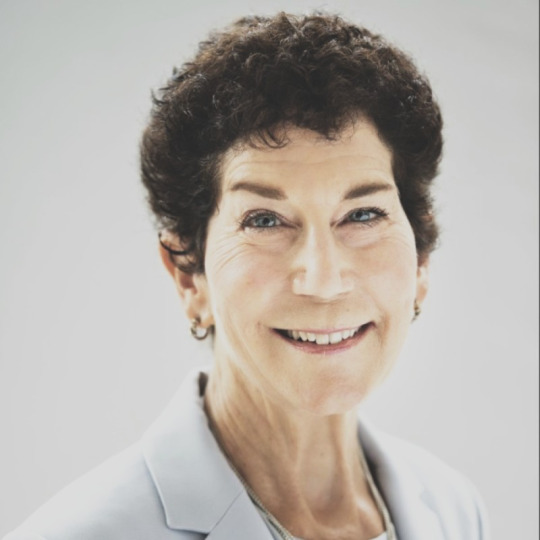
“You have to prove in a criminal case beyond a reasonable doubt that a person drove a vehicle through without paying a toll,” said Lisa Foster, a retired California superior court judge who is now co-director of the Fines and Fees Justice Center, an organization that works to ensure fines are equitably imposed and enforced. “You can’t prosecute a car, you have to prosecute people for doing things illegally.”

It’s also unclear whether some toll operators are giving drivers a chance to dispute registration blocks on their vehicles, The News found.
While state law spells out a person’s right to request a court hearing over a registration block no later than 30 days after they are notified, the NTTA said only two people have set a hearing since it began collecting tolls.
However, an attorney in Dallas who defends people for toll citations provided The News with documents supporting multiple requests he sent to NTTA that went unanswered.
Another troubling dilemma is the fact that it appears that some toll operators might not have processes in place to adequately ensure that drivers understand the fees and fine they are being charged.
The News’ investigation found some people are routinely surprised by penalties.
Sometimes, they occur because drivers don’t know their credit cards stored with the tollway authority have expired, the investigation found.
Other times, it’s because someone sold the vehicle but didn’t notify the state about the sale.
NTTA said it sends notifications to anyone who opts into their alerts.
State lawmakers passed a law last year that now requires tollway operators to notify drivers if the payment methods they link to their NTTA accounts have expired.
Still, the notification efforts haven’t helped Texans like Morris Shepard who, to date, has spent countless hours trying to resolve his issue with NTTA, which pursued him for unpaid tolls when it could not withdraw money from his bank account.
His account was frozen suddenly because of potential fraud, he said.
Shepard, like so many other drivers The News interviewed, still ended up in court.
The News also found that toll enforcement across North Texas overwhelmingly impacts people of color and those who live in low- to moderate-income communities.
The News analyzed 10 years of data, from 2013 to 2023, for roughly 160,000 tickets issued across the state for failure to pay tolls.
The analysis found nearly 40% of defendants were African American drivers like the Shepards, or Fort Worth single mother Dee Davis, who owed $17,200 in tolls and penalties, even though Black people make up only 13% of active license holders in Texas.
The analysis was based on data provided by municipal and justice of the peace courts under a voluntary reporting program of the Texas Department of Public Safety.
Who bears the burden of tolls
A Dallas Morning News analysis of 10 years' worth of unpaid toll tickets found 40% of recipients were African-American motorists.
Our analysis also found that overwhelmingly, toll enforcement across North Texas impacts people of color and those who live in low- to moderate-income communities.
Click on this map to learn how many people have been ticketed for unpaid tolls in your zip code.
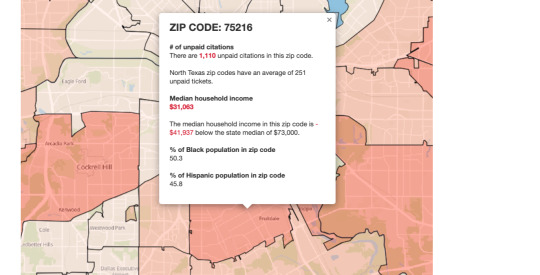
SOURCE: Texas Department of Public Safety, voluntary reporting by Justice of the Peace Courts, Census Bureau. MAP: Shuyao Xiao / The Dallas Morning News
Tollway operators acknowledged that their systems make mistakes.
NTTA, for example, processes close to 3 million transactions a day, St. Pierre said.
Most are undisputed.
But when there’s an error, NTTA corrects it, she said.
The CTRMA in Austin also “strives for fairness” and will dismiss charges if it is proven that its technology or processes were at fault, said spokeswoman Jori Lui.
Bottom line: Taking a toll road is optional, operators said.
“If you don’t like the amount you’re being charged, whether it’s on our roads or any other, don’t do it,” St. Pierre said.
How it started
The collection concerns held by so many people The News spoke to didn’t always exist.
That’s because toll fee collection used to be far simpler.
Those born before 1989 may remember throwing a few quarters in a large bin and waiting for a guard rail to rise as you made it through a toll road.
If you didn’t have the exact amount, you drove to an attended booth for change.
Back then, payment was guaranteed because drivers were forced to stop at a toll plaza to pay or toss money into a catch basket, said Mark Muriello, director of policy and government affairs at the International Bridge, Tunnel and Turnpike Association, a Washington, D.C.-based worldwide association for the owners and operators of toll facilities.
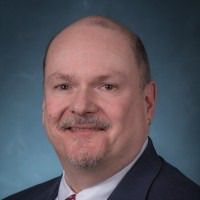
In 1989, North Texas was among the first communities in the country to contract with a company to manage an automatic cash payment system for tolls, according to news reports.
While the changes created a need for more technology, it made the process more efficient, Muriello said.
There were fewer accidents because drivers no longer had to merge into traffic after leaving toll plazas, he said.
By 2009, electronic toll tags largely ended cash-pay tolling.
That’s when drivers started mounting electronic tags they received from tollway operators to their car’s front mirrors.
The tags contained microchips that connected to prepaid toll accounts that drivers set up online.
Now, each time a driver enters a tollway, an electronic reader above the toll road scans the microchip inside the tag and a toll fee is debited from the driver’s account.
For drivers who don’t have toll tags, an image of their license plate is taken and the tollway operator uses it to scan Department of Motor Vehicles records for the car’s registered owner.
Tollway operators then send a bill to the name listed on the DMV’s website as the owner.
The big squeeze
While technology made it easier for drivers to use toll roads, it made it harder for toll operators to collect fees for people without toll tags.
So NTTA doubled down.
By 2010, NTTA began keeping records of vehicle owners who did not have toll tags and frequently used a toll without paying.
It slapped these drivers with fees and penalties, which sometimes added another 80% to their toll costs, according to articles from The News at the time.
Two years later, it created a “Top Violators” webpage that contained the names of individuals who owed money for more than 100 outstanding tolls.
In a 2012 news release, NTTA said the list was designed to provide the public with a way to easily determine if they owed a significant debt and put them on notice that they may be subject to collections lawsuits and other enforcement actions.
Over the next few years, NTTA published additional lists for what it described as “deadbeats.”
The authority sued those who wound up on this list in justice of the peace courts throughout North Texas, News articles show.
CTRMA, which oversees six toll roads in the Austin area, also refers cases to justice of the peace courts, a CTRMA spokeswoman said in an email in response to questions from The News.
By 2013, a new state law gave toll operators another tool to penalize those with unpaid toll fees: the power to impound vehicles and block vehicle registrations.
The registration blocks are allowed in about a dozen states, but lawmakers in states like Oklahoma want to stop them, according to news reports.
To help them more effectively pursue offenders, NTTA and the state’s two other public toll operators for nearly two decades also have relied on help from debt collection attorneys and hired high-profile law firms to represent them.
NTTA also does this work for others.
Private tollway operators pay NTTA to pursue drivers with unpaid toll bills in North Texas justice of the peace courts.

From 2018 to 2023, HCTRA paid $30 million in collection attorney fees in addition to $20 million to Austin law firm Linebarger Goggan Blair & Sampson to pursue other remedies such as registration blocks and driver’s license suspensions on toll evaders, according to records The News obtained from the Houston-area toll operator under the Texas Public Information Act.
From May 2022 to May 2023, NTTA sent nearly 172,000 scofflaw requests to Texas DPS for habitual violator statuses.
The designation, which applies to a driver who has accumulated 100 or more unpaid tolls within 12 months, triggers vehicle registration blocks in Dallas, Denton, Tarrant and Collin counties.
From July 2022 to July 2023, NTTA collected $153 million in toll enforcement remedies, records show.
In total, based on those figures, North Texas counties have lost more than $10.3 million in registration fees that their city leaders cannot collect because of vehicle blocks by toll operators, based on the average cost to register each vehicle, which is $60 in Texas.
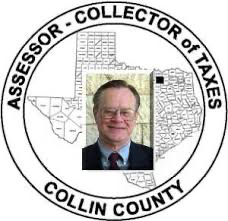
Collin County Tax Assessor Kenneth Maun told The News he refused to enforce the blocks toll operators like NTTA requested for more than a decade.
“I would find them tremendously out of date, items being billed to taxpayers who didn’t know it,” he said. “The car had already been sold one or two times. And, they (NTTA) didn’t clean anything up.”
“I wasn’t going to touch them (NTTA) because I thought they were doing a horrible job, that was for the counties, for the taxpayers, for everybody,” he said.
He finally relented around 2017, he said, when county commissioners included in the county budget three additional full-time positions to help with the workload. But years later, he said not much has changed. Billing errors for NTTA customers still exist, he said.
“I don’t respect their administrative abilities,” Maun said.
The chaos and confusion
Many of the concerns Maun described impact drivers in courts across North Texas every day, The News’ investigation revealed.
In a Frisco courtroom in February, Justice of Peace James DePiazza prepared to issue arrest warrants for people who had failed to respond to his court notices for unpaid toll fees.
He looked up at rows of empty seats. Four
of the five people sitting there that morning said they had addressed their citations with NTTA.
They wondered why they still received court notices.
DePiazza, who serves in Precinct 2 in Denton County, told The News much of his job is spent explaining to the public how the system works.
On that day, he shared from his bench that even if a driver contacts NTTA to address unpaid tolls, they must still enter a plea to address the criminal side of the infraction with the court.
DePiazza scheduled two pretrial hearings for people who pleaded not guilty with the Denton County district attorney’s office in his court that day.
One hearing was for a man who told DePiazza the NTTA had dismissed his charges in a bankruptcy he filed in 2021.
Another hearing was for a man who said he had sold his car before the citation occurred.
DePiazza told the man he needed to file a vehicle transfer notification within 30 days of the sale in order to clear the court citation.
“NTTA can come back and charge you for those tolls” if the buyer doesn’t register the vehicle or he does not file the transfer notice within 30 days of the sale, DePiazza told him.
Then, DePiazza heard his final case that day — and quickly dismissed it.
Seventy-six-year-old grandmother Andrea Peralta of Lewisville had loaned her car to her grandson, she said.
She was on a breathing machine because she caught COVID-19 in 2021 and it damaged her lungs, she said, so she needed to get back home as soon as possible.
“He took off and I guess left me holding the bag,” she said about her grandson.
DePiazza waived court fines after Peralta showed him she was on Social Security.
Peralta said she wasn’t sure how much she owed NTTA, but she sold her car for $300 more than a year ago because she couldn’t afford to fix it.
She couldn’t remember the exact date, though.
“It’s been a while,” she said.
Jeff Beltz, an attorney who defends people who have tollway tickets, waits for a hearing last summer outside the East Dallas Government Center.(Juan Figueroa / Staff Photographer)
Jeffrey Beltz, an attorney who represents people at court hearings over unpaid toll fines, said too often, NTTA representatives do not provide enough evidence to prove a driver is guilty.
The News met Beltz last summer as he waited alone one day in Justice of Peace Sara Martinez’s Dallas court.

NTTA representatives were supposed to attend the court hearing to prove his client’s toll violation, but the court postponed the hearing.
Beltz’s client was on the hook for $380.01 in unpaid tolls in addition to $525 in administrative fees from NTTA, according to a court citation record he shared with The News.
His client’s paperwork included the information that noted the total amount of unpaid tolls owed, but not a breakdown of each tollway violation his client allegedly had incurred.
There was no way his client could verify the charges, he said.
The documents also did not include snapshots from NTTA of the license plate involved in the toll violations.
“If you’re filing a criminal case, how in the world can you sit there with a straight face and say this is enough evidence?” Beltz said. “These are criminal cases and they require the highest burden of proof in the land.”
NTTA also has not responded to requests he has made for hearings to contest blocks on car registrations, Beltz said.
NTTA told The News only two drivers have ever set a hearing to contest a registration block and in each of those cases, the court affirmed the block.
What’s more, NTTA simply follows the law, St. Pierre said.
“If your car is used in the commission of a crime, it’s your car,” she said. “There is a degree of responsibility that comes with owning a vehicle whether it’s paying tolls or making the car payment or keeping it insured.”
A closer look
Between 2013 and 2023, roughly 146,000 of the 160,000 court tickets sent out for violations across the state for unpaid toll violations were concentrated in Tarrant, Dallas, Denton and Collin counties, where NTTA operates, according to data The News reviewed from DPS.
The News called and emailed the state’s three largest toll road operators, HCTRA, CTRMA and NTTA.
Only NTTA agreed to an interview.
When presented with The News’ findings about the actions it takes to punish violators, NTTA officials said it operates fairly.
If a driver is concerned about affordability, there are alternative routes that might better fit their budget, St. Pierre said.
“We’re being asked, ‘Why aren’t you being fair to them?’ when my first question is, ‘Well they used the toll roads, why would they not pay for what they got?’ ”
At the end of the day, St. Pierre said, “We just want what’s owed for using the road.”
Dee Davis, a single mother in Fort Worth, is one of thousands of North Texas motorists who face mounting bills for unpaid tolls.
Texas is one of only a handful of states that criminalizes tollway drivers for unpaid fees.(Tom Fox / Staff Photographer)
Dee Davis, the Fort Worth single mom, was hoping a phone call to NTTA to explain her situation would resolve her $17,200 toll bill.
But their answer surprised her.
She was told that the only payment plan they would accept was at least $300 a month.
Several years ago, her ex-boyfriend used to borrow her car, often driving it on toll roads to get to work.
She had never driven on toll roads.
She guesses that he must have hidden the tollway citations from her, or maybe they had been sent to an old address where they lived before their breakup.
This year, she said she’s already been stopped by police five times on her way home from work for an expired registration sticker.
NTTA blocked her from renewing her car registration because she is a habitual violator.
The status gives NTTA the authority to suspend drivers’ licenses, bar those drivers from using their tollways and impound their cars.
Many habitual violators are everyday Texans working to make ends meet, two judges said in interviews with The News.
They are hair stylists, bartenders, deployed military, single parents and grandmothers.
They are small business owners and construction workers.
Some mistakenly get on a tollway and don’t realize how quickly the fees add up, judges said.
One hundred charges can happen in a few weeks for a driver who passes several stations on a toll road to get to work and back every day.
Morris Shepard had a toll tag on his car.
For years, money was automatically withdrawn from his bank account to pay for his drives on toll roads.
But when his bank account was frozen to protect him after Amazon found potentially fraudulent activity, his bank declined his toll payments.
The Shepards said they never received notice from NTTA that toll payments could not be withdrawn.
They visited an NTTA office in Plano in February after receiving a letter from Denton County Justice of the Peace Precinct 2 that said Morris Shepard could be arrested for unpaid tolls.
They said they were surprised after they explained their situation that NTTA still told them they had to go to court.
Because he’s a disabled military veteran, Morris Shepard is eligible to drive for free on some Texas toll roads under qualifying discount programs accepted by TxDOT and Austin’s regional mobility authority.
NTTA only waives tolls for Legion of Valor members under a program that is subsidized by an anonymous third-party sponsor.
In court that February morning, the judge set Morris Shepard’s next hearing for 9 a.m. on April 11, when he and his wife said they would have in hand documented proof of the fraudulent activity on their bank account.
But the case did not end that day.
And it didn’t matter that he had documents to show that he had not intentionally tried to avoid paying tolls.
At the April 11 hearing, an assistant district attorney with Denton County told Shepard he must still pay the toll fees he owes NTTA.
Shepard also learned he would receive an email with a Zoom link for an upcoming meeting to work out a payment plan with NTTA representatives.
After that, he needed to bring to the court documented proof of his agreement with NTTA and pay $81 in court costs.
Shepard’s ticket for unpaid tolls would be removed from his record if he did not receive another citation in the next 90 days.
In the hallway after the April hearing, Shepard said he was glad his court fees and fines were reduced.
He could have been ordered to pay as much as $331 but the Precinct 2 court reduces fines to incentivize people to clear their citations.
His wife was still upset that despite their proof and talk with NTTA, they still had to go to court and pay toll penalties.
“You get the runaround,” LaTasha Shepard said. “You had to go there first, and then you’ve got to come back here. You’ve got to do all this stuff.”
“This is a redundant process,” she said.
Part 3: As Texas prepares for more growth, lawmakers may soon look for ways to lessen the burden of tolls. In North Texas, one judge slashes fines to “help people take care of their business.”
Penalties don’t have to be extreme, he says. Meanwhile, some states offer rebates and discounts to low-income families and frequent users.
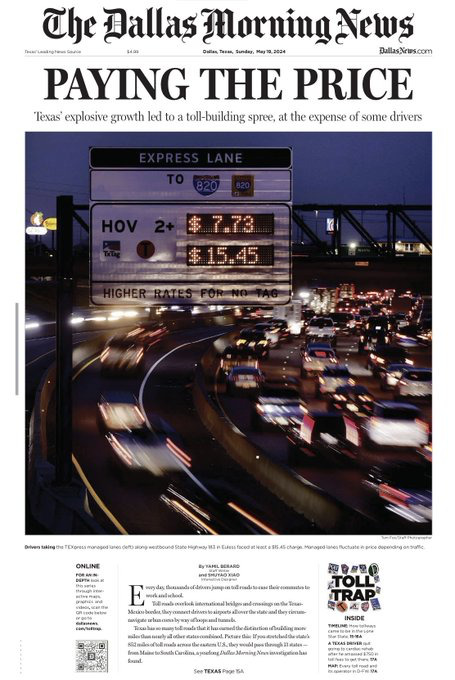
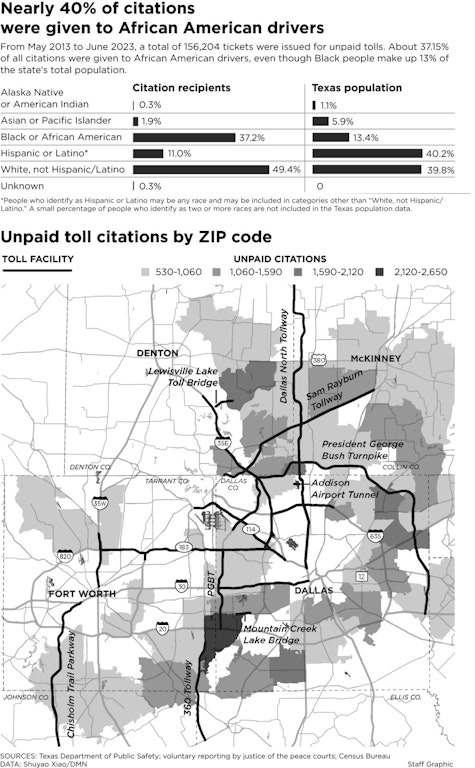
IN THE KNOW
Paying your toll bills
New to tolls and don’t have a toll tag?
Paying them can be confusing, but there are ways to navigate Texas’ paid roads without getting tripped up.
CHECK YOUR MAIL:
When you drive a toll road, a paper bill arrives in the mail about 30 days later. It includes a photo of your license plate, and if you pay the bill within 30 days, you’re done.
If you don’t pay after another 30 days, you receive an overdue notice that includes the unpaid toll charges and a $10 late fee.
If you still don’t pay after another 30 days, you receive an invoice that includes a $35 late fee, in addition to the unpaid toll fees.
COURT CITATIONS:
Stiffer penalties kick in if you wait yet another month.
That’s when your account is sent to a collection agency and the Texas Department of Public Safety, which can issue a court citation for failure to pay tolls.
The court mails a letter to you, as the vehicle’s owner, about the citation and requests that you contact the court to enter a plea of guilty, not guilty or no contest.
CHOOSE A PLEA:
A guilty or no contest plea comes with additional costs — generally about $330 to the court — on top of the unpaid toll and late fees.
A not guilty plea sends your case to the district attorney’s office, where you can request a jury trial or a trial with just a judge.
If you choose to not enter a court plea, the court suspends your driver’s license.
Thousands of driver’s licenses have been suspended related to unpaid tolls over the last year, according to the Texas Department of Public Safety.
The court then sends a letter stating that if you fail to show up by a certain date, a warrant will be issued for your arrest.
HABITUAL VIOLATOR:
If you have 100 or more toll violations during a 12-month period, you are considered a “habitual violator” and the tax assessor’s office blocks you from renewing your vehicle’s registration.

Last year, more than 211,000 registration blocks were issued by two of the state’s largest tollway authorities — the North Texas Tollway Authority in Dallas and the Central Texas Regional Mobility Authority in Austin.
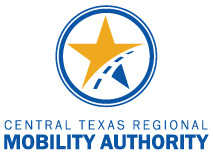
State law also allows tollway operators to ban you from driving on their roads.
So if you are stopped by law enforcement on a tollway, the officer can impound your vehicle.
KEEP RECORDS:
Keep in mind that the onus is on you.
These steps can still occur even if NTTA makes an administrative error or if you sell your car.
That’s because state law mandates that you file a document verifying the sale and change in ownership with the Texas Department of Motor Vehicles within 30 days.
Yamil Berard
0 notes
Text
Jason Lumsden is the Director of IT at Boston Red Sox
Often call tomato sauce "gravy." Apparently it comes from the Italian word sugo, which means gravy. Sugo al pomodoro is tomato gravy, and sugo all is a spicy tomato gravy. Tomato gravy, or tomato pasta sauce, is made of fresh or canned tomatoes with garlic, onion and herbs such as parsley, oregano and basil.
cheap nfl jerseys The old town communities around Holyrood and Cowgate were dispersed to the suburbs cheap jerseys. Modernity was in the air. Under Swan's leadership, Hibernian became another kind of pioneer: floodlights, tours of Germany and Brazil, and (in 1955) the first British team to enter the European Cup. cheap nfl jerseys
Cheap Jerseys free shipping The virus spreads when one comes in contact with the bodily fluids of an infected person. It can also be transmitted through contaminated surfaces, needles, or medical equipment. It must be noted that an infected person is not contagious until he or she exhibits the symptoms of the disease. Cheap Jerseys free shipping
Gabriel went home, wholesale jerseys from china then got the call to return to the arena and grab his gear and get into a Towncar.Gabriel seems to be the Wild designated Winnipeg player. He has played three preseason games against the Jets, two in Winnipeg. On Oct. Conservatives also need to get back into American inner cities. Subsuming all of this; as a country, we need to get over the idea that massive welfare programs help those trapped in poverty. In actuality, they restrain economic mobility and penalize personal responsibility..
cheap jerseys On the final ascent of the Tour de France an epic duel unfolded. One man riding up the mountain like a man possessed. The other unable to stay with the pace, struggling with a cough and desperately trying to retain possession of the yellow jersey that he will, wholesale jerseys with more than a little relief, wear in triumph into Paris on Sunday.. cheap jerseys
wholesale jerseys "I'm in no rush to put advertising on our sweaters," he said. "I think we've got the best jerseys in all of sports. I like the history, the tradition. Team two points and a 5 5 tie at the end of regulation. "The men's sizes are just not tailored to fit a woman's body," says DeLaRosa. This activates the backs of your thighs so you can't use the hip flexors (the opposing muscle group) to create momentum and pull your knees forward. wholesale jerseys
wholesale jerseys from china More than 35,000 visitors are expected to line the roads surrounding the village tomorrow. At the foot of the hill, spectators had already pitched up yesterday in a temporary campsite in a farmer field. Booked this space in February because all the other campsites were already fully booked www.cheapjerseyschinatrade.com, said Tony Baker, who drove his motorhome from Lincolnshire with his wife, Lorraine. wholesale jerseys from china
nfl jerseys What are the Top Rated Rower Machines for Obese People?Back in the early days, I unfortunately learned the hard way that some fitness equipment really isn't meant for everyone and ended up making a bit of a fool of myself. So I wanted to create this account overview of the best rowing machines that are meant for the heavier population, www.cheapjerseyschina8.com being specifically manufactured for heavy duty exercise being catered with extra large seating, added padding etc. (as well as of course excelling in offering you a decent rowing work out). nfl jerseys
wholesale nfl jerseys Jason Lumsden is the Director of IT at Boston Red Sox. Lumsden's experience in technology and business development has afforded him top manager and consultant roles with large organizations across the world. As the Director of IT for the Boston Red Sox, Lumsden guides the team's digital strategy and leads an internal Technology Steering Committee. wholesale nfl jerseys
nfl jerseys By entering a player's name in the site's search function, a potential consumer would be directed to apparel from that athlete's school and even emblazoned with his number. In the case of Manziel, certain Texas A shirts were adorned not just with his No. 2 but also "Football," seemingly a nod to his nickname. nfl jerseys
Combine a profit sharing plan with a Traditional 401(k), and you have the Solo 401(k) plan www.cheapjerseysfromchinasale.com, a retirement savings vehicle designed for sole proprietors with no employees other than their spouses. These plans currently permit you to contribute up to $49,000 annually plus $5,500 in catch up contributions for a total of $54,500 if you are 50 or older.4The Roth 401(k). Imagine a Traditional 401(k) fused with a Roth IRA.
And Afghan forces hit some al Qaida training camps outside of the southern city of Kandahar, close to the Pakistan border. The other thing is this training effort. General John Campbell, the commander there, said they need a lot more help with logistics, getting supplies to their troops in the field.
cheap jerseys "It's been part of my job prepping the guys about what to expect culturally. I know from experience in 2011 a lot of teams arrived here very unprepared about what was going to happen. We felt we did a good job with Wales so we've been working hard to make sure nothing is a surprise.. cheap jerseys
wholesale nfl jerseys I think Veep has torn down the wall between comedy and politics. Our show started out as a political satire, but now it feels more like a sobering documentary. So I certainly do promise to rebuild that wall and make Mexico pay for it.". The Progressive NJ Divorce Lawyer:How to Improve the Quality of Interviews, Meetings and Settlement Conferences by Learning to Use Advocacy and Inquiry More EffectivelyAs NJ divorce attorneys, we are trained to be advocates in the process known as "adversarial. Many of us self selected into the legal profession partly because our underlying personality and temperament traits are geared toward advocacy. Similarly, lawyers "the good ones" are typically quite inquisitive wholesale nfl jerseys.
1 note
·
View note
Text

Since last August, we have been working hard to make this Gran Varones Fellowship happen. When we launched Gran Varones on this date exactly five years ago, it has been our commitment to build power at the community level. It was this very commitment that inspired us to launch the Gran Varones Positive Digital Arts Fellowship. Gran Varones was awarded a grant (our very first!) from ViiV Healthcare to launch a year-long (March 2019 – January 2020) national fellowship to develop the leadership of a cohort of six HIV positive Latinx Gay, Queer, Trans and Bisexual Men ages 21-35. This cohort of creatives will be supported with resources to combat HIV stigma and promote family acceptance in Latinx communities through digital storytelling, community building and cultural organizing.
Through an online application process, we received responses from brilliant applicants from all over the country. Narrowing the list down to six people was almost impossible. In fact, we were originally budgeted to select five fellows but decided on six because, well, why not?
We selected six brilliant creatives from just as many cities. We prioritized creatives who are new to the digital organizing and/or storytelling space. And after sharing time and space with them during our first of two convenings a few weeks ago, we are excited about all of the magic that they will be creating as individuals and as a cohort.
In addition to creating content for GV, each fellow will organize a community-based event. This will expand our commitment of building power through storytelling by making it even more accessible. These six fellows are going to create a new earth! Here are the six Gran Varones Positive Digital Arts Fellowship:

Carlos Moreno (He/They) Los Angeles, CA
A Gemini in his 28th year of existence, Carlos is a proud Chicanx living his truth as an HIV Positive Queer person from Tucson, Arizona. A product of migration, this first generation being strives to make a helpful and lasting impact on the HIV/AIDS community, both globally and locally. He has stood alongside others in the fight against HIV/AIDS in prevention and as well as in care. Unscathed by stigma, He has navigated the last ten years of his life by reclaiming any animosity he's faced and turned it into a therapeutic artistic expressions. A natural introvert himself, Carlos has struck chords with folks using simple imaging and messaging, leaving faces shocked, surprised, amused, or not in agreement, but definitely began a conversation. Carlos wants nothing more than for other Poz folk to join in on this ARTivism movement, share their experiences and connect with others so that we don’t all feel alone, especially Queer and Trans people of Color. It has been a dream of his to see there be space for distributing such products at events where other LGBTQ/Hetero/ HIV/AIDS information is being accessed. Carlos believes that it is important that people living with or affected by HIV/AIDS have access to the same empowering messages the HIV Negative and prevention communities do, that they are equally represented with pride and equity. Without a real push for some financial assistance, these items may only be limited to the creator and not have the opportunity to help inspire other Poz communities to flourish.

José A. Romero (He/They) Durham, NC
is an abolitionist organizer, immigrant defense strategist, and Poz Poet living in Durham, NC. The first in their bio-family born in the “US”, José is the descendant of working-class immigrants from Morazán, El Salvador and Michoacán, Mexico. Born in Washington State and raised between there and Michoacán, José’s political awakening arose while witnessing kindred femmes undo misogyny and while learning English to confront the borders their family endures. José moved to Philadelphia to attend the University of Pennsylvania where they were active in movements to confront anti-blackness/homophobia. In Durham they use their research background and direct-action experience to honor past, present, and future radical ancestors. Inspired by apocalypse and alchemy, José’s abolitionist organizing for black/brown flourishing includes work with Durham Beyond Policing, Durham’s Participatory Budgeting Steering Committee, and various immigrant/queer/trans defenders. They have worked on anti-deportation/sanctuary cases across NC and are a proud member of Southerner’s on New Ground working to end money bail, abolish ICE, and pleasurably undo anti-blackness in Latinx communities. José is currently Directing the first Latinx Southern Regional Health conference for the National Latino Commission on AIDS. They’re working on two collections of poetry titled ICEBREAKERSand POZITIVE. They are the host of an open mic series and queer friendship/dating party collectively called MELT. They make their money working at a queer punk bar, as an interpreter, and as a consultant. You can find/book them at @PupusaPapi_27 on Instagram and @RomeroFlux on Twitter. José dreams of curating an Arabic/Mandarin/Spanish exhibit/mixtape as well as opening and inviting y’all to a mobile Freedom School dedicated to astrobiology, pupusas, synesthesia, and uprising.

J. Aces Lira (He/Him/His) Chicago, IL
Aces Lira is an MSW/MA graduate student in Women Studies and Gender Studies at Loyola University Chicago. As a Research Assistant, he is based in the US Regional Network within the International Partnership for Queer Youth Resilience (INQYR) and is getting a foot in the door on all things research-related. Outside of the books, Aces orchestrates portraits along with art through different mediums and also lives for National Park excursions.

Marci Garcia (He/Him/His) Brownsville, TX
Sometimes life feels just like one of those theatrical plays or big screen movies; a bunch of dialogue, drama, adventure, tragedy and tears, and a lot of laughter and happy moments as well, all combined. My movie opens in Mexico, born and raised until the age of 10. I was a lucky boy that grew up in a very loving family; abuelos, tios, primos and my beautiful parents and brother always by my side. Still, I was a lonely kid. A kid that knew he was different and had a very a hard time fitting in, all the way through high school and college years. Never an obstacle to aspire to go out in the world and follow my dreams though. Today, I feel I am blessed and thankful to life for being different. I didn’t choose to be who I am, I just got lucky. Throughout my professional career I have wanted to find the place where I know I am not only getting a paycheck but also making a positive difference somehow. Again, through life’s unique way of arranging things I believe I have found that. I am currently part of an extraordinary non-profit organization whose goal is to provide sexual education, HIV prevention and wellness services to the community of South Texas. Being here truly inspires me to become more involved, gain knowledge and to help out combat the HIV stigma that is still out there. I know because I see it, I hear it, I live it. I believe I am working for this agency for a reason. I believe I am ready to accept and say who I am, what I am and what I aspire to become.

Dimetri O’Brien (He/Him/His) Washington, DC
Strategic, multidisciplinary designer & social media coordinator with a spirit for service & innovation born in Port of Spain Trinidad with roots in Jackson, MS . Dimetri has worked with a multitude of clients on projects ranging from graphic design to consultation & management and although his skill set is vast, his greatest expertise revolves in the worlds of programming for YMSM ages 18-29, social media, brand identity design, content creation and print collateral. Dimetri currently serves as a communications assistant in Washington, DC managing communications and branding for a national non-profit agency. His graphic design portfolio can be viewed at "dimmydoesit.com"

Raúl Xavier Ramos (He/Him/His/They/Them/Theirs) Brooklyn, NY
Raúl is a 26-year-old Boriqueer social justice organizer based out of Brooklyn, New York. Using graphic design and performance art as forms of accessible political education , Raúl is dedicated to the liberation of all queer and Gender Non-conforming people of color, persons with disabilities, and those that experience realities in ways the culture would call "mentally ill." Healing justice is at the center of Raúl's work, having become Poz at the turning point of his adult life. He is unapologetic in how he loves and in the ways he fights for justice.

#thegranvarones#granvarones#queer#non-binary#gay#latinx#afrolatinx#hiv#poz#aids#storytelling#creatives#lgbtq#qtpoc#community#end stigma
17 notes
·
View notes
Text
Mobile Development in Southern Texas
On the fastest growing mobile app development technology, we are delivered the best Mobile Development in Southern Texas to makes your industry helpful and better. Contact us and get the best application for you
0 notes